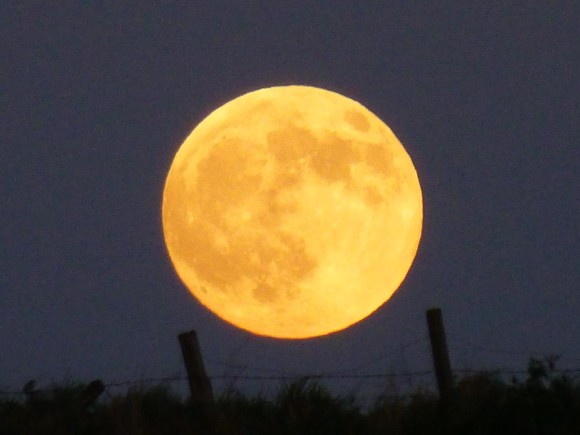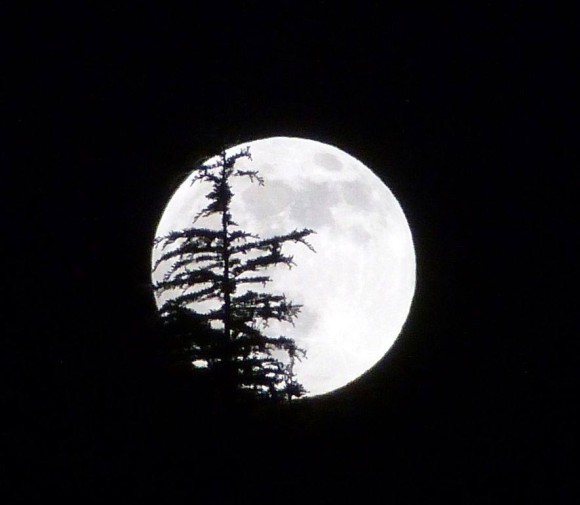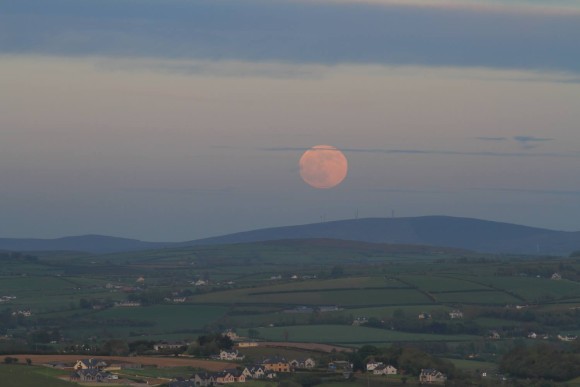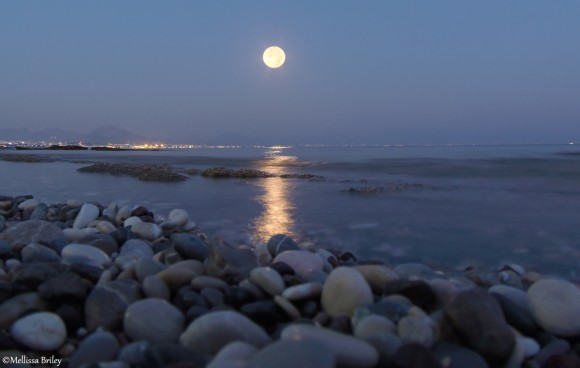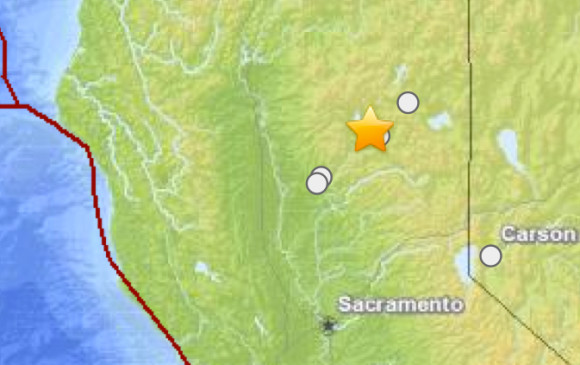Claire Glenn Atteberry
Shared posts
New, simple theory may explain mysterious dark matter

Most of the matter in the universe may be made out of particles that possess an unusual, donut-shaped electromagnetic field called an anapole.
This proposal, which endows dark matter particles with a rare form of electromagnetism, has been strengthened by a detailed analysis performed by a pair of theoretical physicists at Vanderbilt University: Professor Robert Scherrer and post-doctoral fellow Chiu Man Ho. An article about the research was published online last month by the journal Physics Letters B.

This composite image shows the distribution of dark matter, galaxies, and hot gas in the core of the merging galaxy cluster Abell 520, formed from a violent collision of massive galaxy clusters. Credit: NASA, ESA, CFHT, CXO, M.J. Jee (University of California, Davis), and A. Mahdavi (San Francisco State University)
“There are a great many different theories about the nature of dark matter. What I like about this theory is its simplicity, uniqueness and the fact that it can be tested,” said Scherrer.
Elusive particle
In the article, titled “Anapole Dark Matter,” the physicists propose that dark matter, an invisible form of matter that makes up 85 percent of the all the matter in the universe, may be made out of a type of basic particle called the Majorana fermion. The particle’s existence was predicted in the 1930’s but has stubbornly resisted detection.
A number of physicists have suggested that dark matter is made from Majorana particles, but Scherrer and Ho have performed detailed calculations that demonstrate that these particles are uniquely suited to possess a rare, donut-shaped type of electromagnetic field called an anapole. This field gives them properties that differ from those of particles that possess the more common fields possessing two poles (north and south, positive and negative) and explains why they are so difficult to detect.
Common electromagnetism, not exotic forces
“Most models for dark matter assume that it interacts through exotic forces that we do not encounter in everyday life. Anapole dark matter makes use of ordinary electromagnetism that you learned about in school – the same force that makes magnets stick to your refrigerator or makes a balloon rubbed on your hair stick to the ceiling,” said Scherrer. “Further, the model makes very specific predictions about the rate at which it should show up in the vast dark matter detectors that are buried underground all over the world. These predictions show that soon the existence of anapole dark matter should either be discovered or ruled out by these experiments.”
Fermions are particles like the electron and quark, which are the building blocks of matter. Their existence was predicted by Paul Dirac in 1928. Ten years later, shortly before he disappeared mysteriously at sea, Italian physicist Ettore Majorana produced a variation of Dirac’s formulation that predicts the existence of an electrically neutral fermion. Since then, physicists have been searching for Majorana fermions. The primary candidate has been the neutrino, but scientists have been unable to determine the basic nature of this elusive particle.
Invisible to telescopes

Comparison of an anapole field with common electric and magnetic dipoles. The anapole field, top, is generated by a toroidal electrical current. As a result, the field is confined within the torus, instead of spreading out like the fields generated by conventional electric and magnetic dipoles. (Michael Smeltzer / Vanderbilt)
The existence of dark matter was also first proposed in the 1930’s to explain discrepancies in the rotational rate of galactic clusters. Subsequently, astronomers have discovered that the rate that stars rotate around individual galaxies is similarly out of sync. Detailed observations have shown that stars far from the center of galaxies are moving at much higher velocities than can be explained by the amount of visible matter that the galaxies contain. Assuming that they contain a large amount of invisible “dark” matter is the most straightforward way to explain these discrepancies.
Common electromagnetism, not exotic forces
Scientists hypothesize that dark matter cannot be seen in telescopes because it does not interact very strongly with light and other electromagnetic radiation. In fact, astronomical observations have basically ruled out the possibility that dark matter particles carry electrical charges.
More recently, though, several physicists have examined dark matter particles that don’t carry electrical charges, but have electric or magnetic dipoles. The only problem is that even these more complicated models are ruled out for Majorana particles. That is one of the reasons that Ho and Scherrer took a closer look at dark matter with an anapole magnetic moment.
“Although Majorana fermions are electrically neutral, fundamental symmetries of nature forbid them from acquiring any electromagnetic properties except the anapole,” Ho said.
The existence of a magnetic anapole was predicted by the Soviet physicist Yakov Zel’dovich in 1958. Since then it has been observed in the magnetic structure of the nuclei of cesium-133 and ytterbium-174 atoms.
Particles with familiar electrical and magnetic dipoles, interact with electromagnetic fields even when they are stationary. Particles with anapole fields don’t. They must be moving before they interact and the faster they move the stronger the interaction. As a result, anapole particles would have been have been much more interactive during the early days of the universe and would have become less and less interactive as the universe expanded and cooled.
The anapole dark matter particles suggested by Ho and Scherrer would annihilate in the early universe just like other proposed dark matter particles, and the left-over particles from the process would form the dark matter we see today. But because dark matter is moving so much more slowly at the present day, and because the anapole interaction depends on how fast it moves, these particles would have escaped detection so far, but only just barely.
Mammatus clouds over Half Dome

Half Dome is a beloved granite dome in Yosemite National Park in California. It’s a granite crest rising more than 4,737 feet (1,444 meters) above the floor of Yosemite Valley. Kristal Leonard caught this photo of Half Dome topped by mammatus clouds on June 2, 2013. Thank you, Kristal!
Green Gazpacho
If you’ve never had gazpacho before, it’s basically a soup for people who, like me, would like nothing more than to eat salsa with a spoon. Okay, maybe that’s just my definition of it, but you get the idea. Lots of yummy vegetables puréed into a deliciously fresh soup.
There are red gazpachos and green gazpachos and about a million ways to make each one. This is my second go at green gazpacho this week and I think I hit the nail on the head this time. My first attempt used bread to add body and a little buttermilk to brighten things up. It was just “meh.” This version uses avocado to add body and a little lemon juice to brighten things up, and it’s much better (gluten free and vegan, too!). This cold soup is fresh, light, and 100% summer. Love it!
The other reason I love this soup is because it takes advantage of the fresh, inexpensive produce of summer. People who have gardens often have an abundance of cucumber and bell pepper in particular, so try to befriend someone with a green thumb. Promise to make them some of this yummy soup in exchange for some of their extra produce! ;D If you can’t find any freebies, all of these ingredients are usually fairly inexpensive in the summertime, so you can eat this gazpacho to your heart’s content.
Let it chill in the fridge and then serve it along side your favorite grilled meats or vegetables and add a big chunk of crusty bread for dipping. That right there, my friends, is what I call a meal!
Have I mentioned how much I love summer?
Green Gazpacho
- 2 medium cucumbers $1.00
- 1 medium white onion $0.81
- 1 medium green bell pepper $0.50
- 1 clove garlic $0.08
- 1 medium avocado $1.19
- ¼ bunch fresh parsley $0.19
- ¼ bunch fresh cilantro $0.19
- 2 Tbsp olive oil $0.32
- 1 tsp salt $0.05
- 1 Tbsp lemon juice $0.06
- 1 cup water $0.00
- Remove the ends from the cucumber and slice it in half lengthwise. Scrape the seeds out with a spoon and then chop the cucumber into chunks. Remove the seeds from the bell pepper and also cut it into chunks. Dice the onion. Add the cucumber, bell pepper, onion, and garlic (peeled) to a food processor. Process until the vegetables are minced.
- Pull the leaves from about ¼ of the parsley and cilantro bunches. Add the leaves to the food processor along with the olive oil and the flesh from the avocado. (Need help learning how to cut the avocado? Check this tutorial.) Purée until smooth.
- Add the water, one tablespoon of lemon juice, and one teaspoon of salt. Purée until smooth again. Taste the soup and adjust the salt or lemon juice if desired.
- Serve immediately or chill until ready to eat.
Step by Step Photos
 This is the fresh produce that I used… I got a great deal on everything because just about all of it is in season right now. Cucumbers and bell peppers were both 2/$1. Parsley and cilantro are pretty inexpensive year round – they were $0.75/bunch today. Vidalia onions would also be great in place of the white onion.
This is the fresh produce that I used… I got a great deal on everything because just about all of it is in season right now. Cucumbers and bell peppers were both 2/$1. Parsley and cilantro are pretty inexpensive year round – they were $0.75/bunch today. Vidalia onions would also be great in place of the white onion.
 You’ll want to remove the cucumber seeds as they won’t blend up well in the soup. Just slice the cucumber in half and then scrape them out with a spoon. I did not remove the skin of the cucumbers. Chop the cucumbers into small chunks before adding to the food processor.
You’ll want to remove the cucumber seeds as they won’t blend up well in the soup. Just slice the cucumber in half and then scrape them out with a spoon. I did not remove the skin of the cucumbers. Chop the cucumbers into small chunks before adding to the food processor.
 Also chop the bell pepper and onion. You can add the garlic whole (but peeled). The processor was pretty much full at this point, so I processed until the vegetables were minced, just to make room for more ingredients.
Also chop the bell pepper and onion. You can add the garlic whole (but peeled). The processor was pretty much full at this point, so I processed until the vegetables were minced, just to make room for more ingredients.
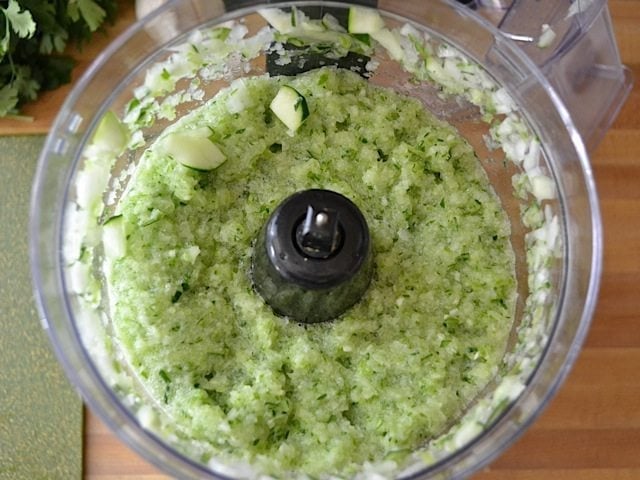 Just a preliminary mincing of the veggies…
Just a preliminary mincing of the veggies…
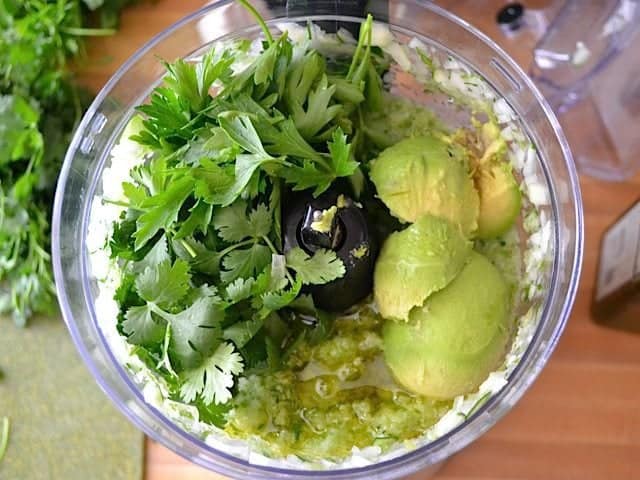 Next, add a handful (or about 1/4 bunch) of each parsley and cilantro. Scoop the avocado flesh from the skin and add it as well. I also added the olive oil at this point. The avocado makes it creamy and adds body. If you don’t add it the soup will just be a bunch of vegetable fiber floating around in juice… not nearly as cohesive (or appetizing).
Next, add a handful (or about 1/4 bunch) of each parsley and cilantro. Scoop the avocado flesh from the skin and add it as well. I also added the olive oil at this point. The avocado makes it creamy and adds body. If you don’t add it the soup will just be a bunch of vegetable fiber floating around in juice… not nearly as cohesive (or appetizing).
 The soup is almost done at this point, but it definitely needs a little sprucing up. I added a little lemon juice for brightness and just a little salt to help the flavors pop. I also added a cup of water to help it blend into a smoother texture and make it more soup-like.
The soup is almost done at this point, but it definitely needs a little sprucing up. I added a little lemon juice for brightness and just a little salt to help the flavors pop. I also added a cup of water to help it blend into a smoother texture and make it more soup-like.
 See? Much smoother now… and DELICIOUS! Make sure to taste it and give it some adjustments. The amount of salt and lemon juice you will need will depend greatly on the size and flavor of your vegetables. They’re quite variable, so each batch will probably need some tweaking.
See? Much smoother now… and DELICIOUS! Make sure to taste it and give it some adjustments. The amount of salt and lemon juice you will need will depend greatly on the size and flavor of your vegetables. They’re quite variable, so each batch will probably need some tweaking.
 Yesss… dip some sour dough or focaccia bread in there. Mmmm.
Yesss… dip some sour dough or focaccia bread in there. Mmmm.
The post Green Gazpacho appeared first on Budget Bytes.
World Oceans Day is June 8

The ocean is one of Earth’s most precious resources. It covers 71% of the Earth’s surface and holds 97% of our planets water. The ocean plays an integral role in regulating Earth’s climate and weather. Many diverse and beautiful creatures inhabit the ocean. The ocean provides us with food, medicine and various other economic and recreational opportunities. Much of the ocean remains unexplored. For all of these reasons, Saturday – June 8, 2013 – is World Oceans Day, an event aimed at celebrating the ocean and raising awareness about the need to protect ocean health.
Organizers are also urging people to wear blue on Saturday to help raise awareness about the ocean, and to commit to practicing simple steps that can protect the ocean such as picking up trash at your local beach and drinking from reusable water bottles.

Photo credit: joiseyshowaa
Presently, the health of the ocean is being threatened by pollution, overfishing, invasive species and rising ocean acidity due to climate change. Another troubling issue is that when people were asked by World Oceans Day organizers about how much of an impact they thought they could have on solving ocean-related environmental problems, 40% of respondents replied “none” or “not very much.”
To help demonstrate that individual people can have a significant impact on solving environmental problems, event organizers are encouraging people to participate in any one of the hundreds of activities posted on the World Oceans Day website.
Look here for a 2013 World Oceans Day event near you
Canada first proposed the concept for World Oceans Day in 1992 at the Earth Summit in Rio de Janeiro. In December 2008, a United Nations resolution designated June 8 of each year as World Oceans Day.
The Ocean Poject and the World Ocean Network have helped to promote and coordinate World Oceans Day since 2002. These organizations work with aquariums, zoos, museums, conservation organizations, schools and businesses to plan World Oceans Day activities around the world.
During World Oceans Day, people are encouraged to learn about the ocean and think about what the ocean means to them with the hopes of conserving it for present and future generations.
In honor of World Oceans Day, New York City’s Empire State Building will be lit on the evening of June 8 in white, blue and purple. The colors are meant to symbolize the different layers of the ocean. White represents the shallow sunlight waters and the polar ice cap. Blue represents the expansive ocean waters that cover the planet, and purple represents the deepest reaches of the ocean.
Bottom line: Saturday, June 8 is World Oceans Day, an event aimed at celebrating the ocean and raising awareness about the need to protect ocean health. During World Oceans Day, people are encouraged to learn about the ocean and think about what the ocean means to them with the hopes of conserving it for present and future generations.
30 Summer Salads

We're in the middle of summer right now and summer is definitely the salad season! Salads are amazingly versatile in that they can contain so many different things from a basic lettuce, cucumber and tomato salad to chicken salads, to potato salads, etc., they can be served either hot or cold and they can be everything from a side dish to a main course. After a long hot summer day I somethings don't feel like cooking, or eating a hot or heavy meal and a light, cool and crisp salad is the perfect solution! Summer is a great time for salads since there are so many fresh vegetables and fruits that can be used in them and as the ones that are available change, your salads change ensuring that they are always exciting! After thinking about salads so much I figured that it was about time that I gathered a few of my favourites and shared them with you and below you have 30 of them along with a few tasty dressings!
Look for the legendary green flash

The mock mirage and green flash image at the top of this post was taken by Jim Grant, an EarthSky friend on Facebook. He captured it on September 3, 2020, off the coast of Ocean Beach, California. Thank you, Jim!
It’s not hard to see a green flash with the eye alone, when sky conditions are right, and when you’re looking toward a very clear and very distant horizon. That’s why those who live near an ocean tend to report green flashes most often. A sea horizon is the best place to see them.
The video below, posted to EarthSky by Vladek in 2016, is an excellent example of the experience of seeing a green flash:
Most people see green flashes just at sunset, at the last moment before the sun disappears below the horizon. Be careful and don’t look too soon. If you do look too soon, the light of the sunset will dazzle (or damage) your eyes, and you’ll miss your green flash chance that day. But if you wait – looking away until just the thinnest rim of the sun appears above the horizon – that day’s green flash could be yours.
Of course, the green flash can be seen before sunrise, too, although it’s harder at that time of day to know precisely when to look.

Mock mirage and green flash seen from San Francisco in 2006. Image via Brocken Inaglory/Wikimedia Commons.
There are many different types of green flash. Some describe a streak or ray of the color green … like a green flame shooting up from the sunrise or sunset horizon.
The most common green flash, though – the one most people describe – is a flash of the color green seen when the sun is nearly entirely below the horizon.
Again … you need a distant horizon to see any of these phenomena, and you need a distinct edge to the horizon. That’s why these green flashes, streaks, and rays are most often seen over the ocean. But you can see them over land, too, if your horizon is far enough away. Pollution or haze on the horizon will hide this instantaneous flash of the color green.

Jim Grant photographed this green flash on April 27, 2012, off the coast of San Diego.
If you’re interested in green flashes, Andrew Young’s green flash page is great. He also has a page of links to pictures of green flashes taken by people from around the globe.
And, of course, Les Cowley at the great website Atmospheric Optics devotes many pages to the green flash phenomenon. Notice the menu bar at the left side of the page; it’ll let you explore many different types of green flashes.
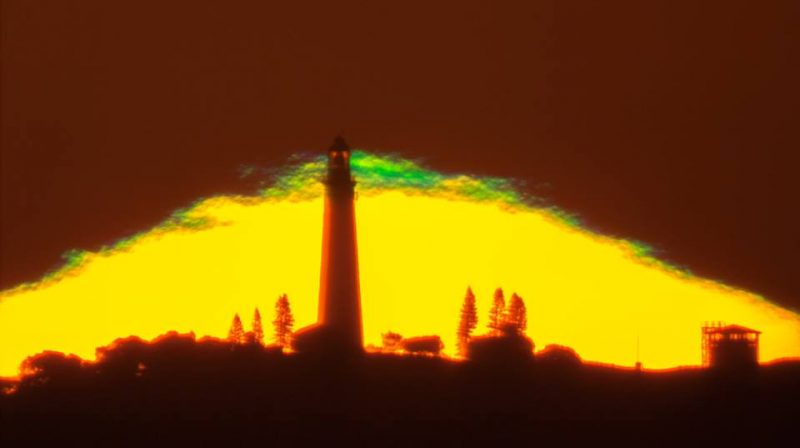
A green flash atop a sun pyramid with the Rottnest island lighthouse in the foreground was captured by astrophotographer Colin Legg from Cottesloe beach, Australia, in 2014. Image via Colin Legg.
Bottom line: The green flash is legendary, and some people have told us they thought it was a myth, like a unicorn or a pot of gold at the end of a rainbow. But green flashes are very real. You need a distant and exceedingly clear horizon to see them at the last moment before the sun disappears below the horizon at sunset.
Enjoying EarthSky so far? Sign up for our free daily newsletter today!

Are you an early riser? Then catch the old moon beneath the line-up of three bright morning planets: Jupiter, Saturn and Mars.
Edward Gibbon
Your best photos: May 2013 supermoon

The May 24-25 full moon moon is one day away from lunar perigee – the moon’s closest point to Earth for this month. By a newly coined popular definition, that makes this May full moon a supermoon. And as the line of sunsets has swept westward today, bringing night from the Far East to the Western Hemsiphere, we’ve enjoyed seeing your awesome supermoon photos. Thank you so much for posting them to the EarthSky Facebook page and Google+. We love them! Keep posting, and we’ll keep adding to the gallery as the sun sets – and the moon rises – further west.
Read about the next supermoon: June 23, 2013

Photo by Tim Martindale, who wrote, “Tonight’s ‘supermoon’ rising over Bude and Stratton. Take a look outside now – it’s a beauty!” May 24, 2013.
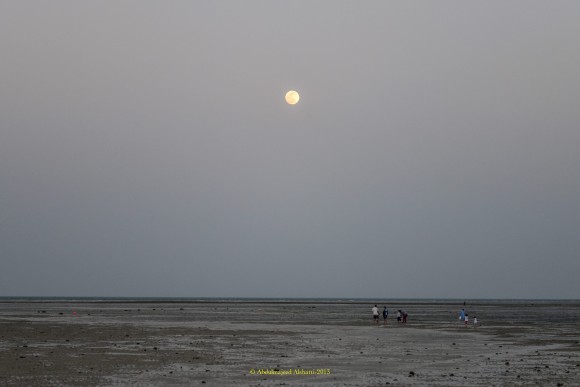
Abdulmajeed Alshatti wrote, “Enjoying the supermoon and the low tide. May 24,2013. Kuwait.” Because the moon is now full, and nearly at its closest to Earth, extra high and extra low tides can be expected.

Photo credit: Priya Kuman. She wrote, “24th May ’13 . Super Moon ……Flowers for the beautiful white bride of the sky — in Muscat, Masqat.”
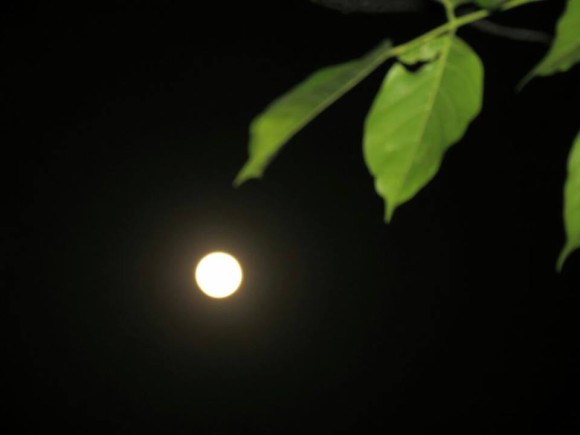
The May 24-25, 2013 supermoon from Hyderabad, India. Photo credit: Kausor Khan

May 24-24, 2013 supermoon from Medan, Indonesia. Photo credit: Apple Saragih
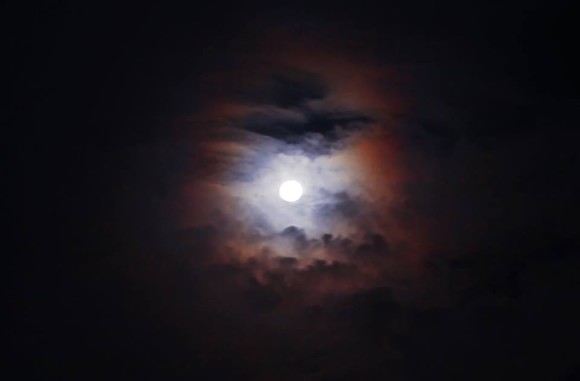
May 24-25, 2013 supermoon. Malang, East Java, Indonesia. Photo credit: Bagoes Setiawon
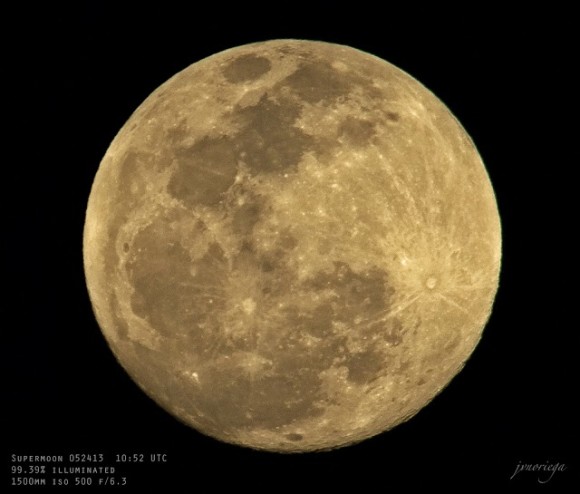
May 24-25, 2013 supermoon from the Philippines. Photo credit: jv noriega

Photo credit: Raven Yu. She wrote,”Rising Full Flower Moon and an airplane (luck shot). 24 May 2013 17:53, Marikina City, Philippines. I was taking a photo of tonight’s moon when a plane flew through. I didn’t even notice it with my naked eyes.”

Photo credit: Frederick Dalpay
Send us your photos via EarthSky on Facebook, EarthSky’s photo community on Google+, and/or e-mail: images@earthsky.org.
New insights on climate change and species interactions

UCLA life scientists provide important new details on how climate change will affect interactions between species in research published online May 21 in the Journal of Animal Ecology. This knowledge, they say, is critical to making accurate predictions and informing policymakers of how species are likely to be impacted by rising temperatures.
“There is a growing recognition among biologists that climate change is affecting how species interact with one another, and that this is going to have very important consequences for the stability and functioning of ecosystems,” said the senior author of the research, Van Savage, an assistant professor of ecology and evolutionary biology and of biomathematics at UCLA. “However, there is still a very limited understanding of exactly what these changes will be. Our paper makes progress on this very important question.”

Image Credit: Toby Hudson
Climate change is causing global increases in mean temperature, as well as more fluctuations and greater variability in temperature. Growing evidence suggests these changes are altering when and how species interact, and even which species are able to interact without going extinct, Savage said.
Already, climatic warming is rapidly altering the timing and rate of flowering in plants, as well as breeding and migration in animals — changes that are likely to disrupt interactions between species.
“These changes may bring about novel and potentially unstable species interactions by causing warm-adapted species to seek out geographic regions and to experience seasonal periods that have historically been too cold for them until temperatures begin to rise,” said lead author Anthony Dell, a former UCLA postdoctoral researcher now at Germany’s University of Gottingen.
Such changes could destabilize entire ecosystems, such as rainforests or coral reefs, said co-author Samraat Pawar, a former UCLA postdoctoral researcher currently at the University of Chicago, who noted that although biologists are becoming increasingly aware that changes in species interactions are likely to be one of most important biological impacts of climate change, they have found it challenging to understand and predict.
Savage’s research team has recently made significant progress on this front by developing a biotraits database. This massive dataset has been compiled from the literature and has been standardized and organized so that data can be combined and compared. This group has already used statistical analysis and mechanistic mathematical models to provide information on how various biological traits of organisms respond to changes in temperature and other environmental factors.
In particular, Savage and his team have looked at the impact temperature changes can have on the rate at which an organism uses energy, known as the metabolic rate. This fundamental process governs many aspects of an organism’s life, including how much food it will eat, how fast it can move, how much it sleeps and how fast its heart beats. The team makes predictions about how an organism’s activity — and thus the broader ecology — are affected by temperature.
In the current research, Savage and his colleagues examined how organisms’ different physiological responses to rising temperatures could impact what are known as consumer–resource interactions. These are interactions between two organisms that lead to a “feeding” event — a prime example being a predator (consumer) and its prey (resource). Taken as a whole, a collection of consumer–resource interactions constitutes the food chain or food web that drives the diversity, dynamics and stability of particular communities and ecosystems.
Their model accounts for the fact that a change in temperature is likely to result in some predators becoming better at capturing prey while some prey animals become more efficient at evading capture, leading to imbalances in the food chain and potential repercussions for ecosystems.
A key biological trait driving different responses to temperature change among consumers and resources is body velocity — the speed at which an animal moves. Cold-blooded animals, for example, tend to move faster as their body temperature increases. The biologists predict that one of the primary impacts of global warming will be increasing the amount of time and speed with which organisms move around a landscape and thus encounter and interact with one another.
Specifically, the researchers say, the effects of climatic warming will be determined by the ways in which predators seek their prey — by moving around the landscape in search of mobile prey (active-capture), by remaining stationary and waiting for moving prey (sit-and-wait) or by moving around in search of immobile prey (grazing) — as well as by whether interacting predator–prey species are both cold-blooded, both warm-blooded or one of each.
Because of the effect of temperature on body velocity, biologists predict that encounter rates between predators and prey will increase with rising temperatures if the foraging strategy is active-capture (both predator and prey moving through the landscape), as with an eagle hunting a fish. However, if both species respond to temperature in identical ways, these changes may not lead to significant shifts in their interactions.
With a sit-and-wait strategy, often used by snakes and lizards, the effects of temperature change would arise primarily via the moving prey species, potentially creating a very strong asymmetry between predator and prey. In this case, the asymmetry may profoundly alter the nature of the interaction, so that the two species have much higher or lower abundances and may no longer be able to coexist in the feeding relationship without one or both going extinct.
Similarly, increasing temperatures are likely to have significant impacts on interactions between warm-blooded and a cold-blooded animals, such as warm-blooded birds that feed on cold-blooded lizards, or snakes that feed on squirrels. In these cases, the internal body temperature of the cold-blooded animal — the lizard or snake — will vary when the climate changes. As a result, the organism’s physiology will change and, in turn, influence its body velocity, activity and reaction rates. In contrast, warm-blooded animals, whose body temperature is largely independent of external climate, will not experience much change, again creating an asymmetry between species.
Using the biotraits database, the authors show that trait-specific asymmetries exist in organisms’ responses to temperature change and are likely to be a major factor in determining the effects of climate change on species interactions.
Naturally, the researchers say, it is impossible to study all the species on the planet, but with their new mathematical model, predictions can be made about effects of warming on different types of consumer–resource interactions.
“The large diversity of species that make up natural ecosystems mean it is logistically infeasible to study every species interaction in a community and make predictions about how these interactions will be affected by climate warming,” Savage noted. “However, models that assume all species respond to temperature in the same way will both miss the large diversity in ecological systems and therefore miss the most important consequences that arise from differential and asymmetric responses to temperature among species.”
“In this paper we forge a middle ground between these two extremes,” Dell said. “We allow different species to have different thermal responses and show this is essential for predicting species responses to climate change, while also having our categories be much broader than every species on the planet. This new model can help form the foundation for a more predictive framework for understanding the effects of climate change on communities and ecosystems.”
Via UCLA
What’s a supermoon? We’re about to have 4 in a row
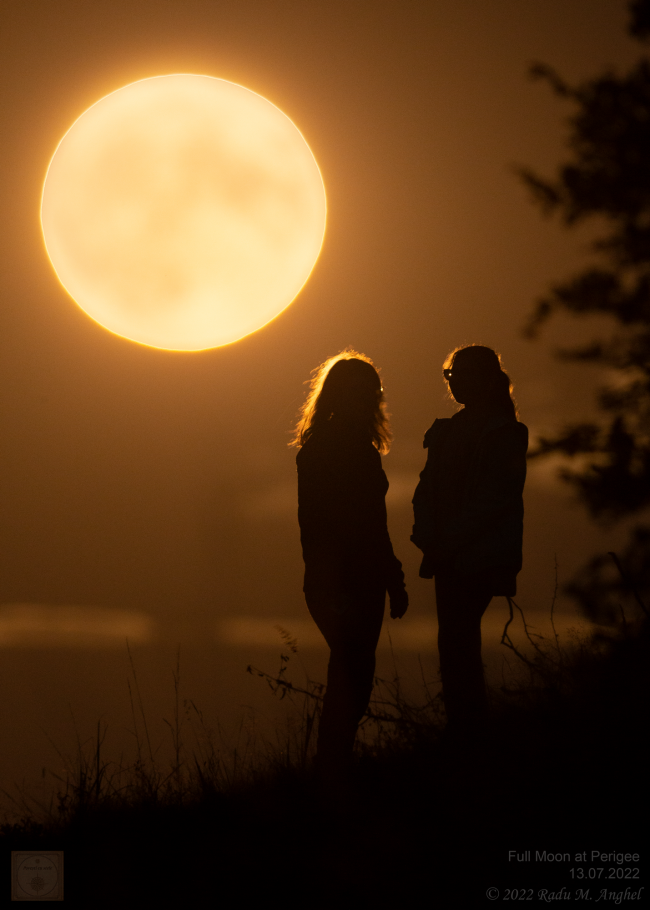
The full supermoons in 2024 will be:
Aug 19: 224,917 miles (361,969 kilometers)
Sep 18: 222,131 miles (357,485 kilometers)
Oct 17: 222,055 miles (357,363 kilometers)
Nov 15: 224,853 miles (361,866 kilometers)
The coming full supermoon will be on August 19, 2024. This full moon is also a Blue Moon.
The full supermoon of September 18, 2024, will be a Super Harvest Moon. Plus, it’ll undergo a partial lunar eclipse.
Then comes the full supermoon of October 17, 2024. It’ll be a Super Hunter’s Moon and the closest full supermoon for 2024.
What’s a supermoon?
2024 has a lot of supermoons! There were five new supermoons earlier this year, and now we will have four full supermoons in a row, for the coming four months. So … what’s a supermoon?
New moon happens when the moon (in its monthly orbit of Earth) goes more or less between the sun and Earth. Full moon happens when the moon (in its monthly orbit) is on the opposite side of Earth from the sun. And perigee – from the root words peri meaning near and geo meaning Earth – is the moon’s closest point to Earth in a month.
So the new or full moon closely coincides with perigee several times each year. When that happens, in the language of popular culture, we have a supermoon.
What’s our source?
Note that different people define supermoons slightly differently. We use Fred Espenak’s full supermoon table to give us dates and moon distances for full supermoons in 2024. Contrast the moon distances above – for 2024’s four full supermoons – to the moon’s average distance of 238,900 miles (384,472 km).
Also note that Fred’s dates and times are in UTC. So some supermoons may fall on the previous date your local time.
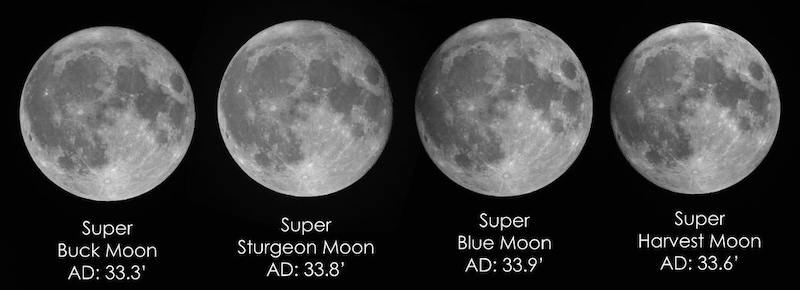
Supermoons came from popular culture
Where did the term supermoon originate? As it’s used today, the word supermoon was coined by astrologer Richard Nolle in 1979. And according to Nolle’s definition, a full moon or new moon is a supermoon when it’s also within 90% of its closest point to Earth. However, different websites calculate supermoons differently.
As mentioned above, EarthSky uses supermoon dates as determined by astronomer Fred Espenak. He’s best known for his time at the Goddard Space Flight Center, where he became a world expert on eclipse predictions. Additionally, his method of calculating supermoons takes into account changes in the moon’s orbit during each lunar cycle.
Supermoon hype?
Some astronomers complain about the name supermoon. They like to call supermoons hype. But supermoons aren’t hype. They’re special. Many people now know and use the word supermoon. In fact, we even notice some diehards are starting to use it now. Such is the power of folklore.
The hype aspect of supermoons probably stemmed from an erroneous impression people had when the word supermoon came into popular usage a few decades ago. Some people mistakenly believed a full supermoon would look much, much bigger to the eye. But it doesn’t. Nowadays, most people seem to realize that supermoons don’t look bigger to the eye than ordinary full moons.
It’s true experienced observers do say they can detect a difference. But you’d have to be a very keen observer to notice it.
Most of us can’t tell any difference in the size of a supermoon and an ordinary full moon.
Is a supermoon brighter?
But … supermoons do look brighter than ordinary full moons! By a noticeable amount. That’s because a supermoon exceeds the disk size of an average-sized moon by up to 8% and the brightness of an average-sized full moon by some 15%. And then, it exceeds the disk size of a micromoon (a year’s most distant and therefore smallest full moon) up to 14% and the brightness of a micromoon by some 30%. So go outside on the night of a full supermoon. Even if you’re a casual observer of the moon, there’s the potential you’ll notice the supermoon is exceptionally bright!
For a visual reference, the size difference between a supermoon and micromoon is proportionally similar to that of a U.S. quarter versus a U.S. nickel. Again, that difference isn’t noticeable to the eye at the moon’s distance. But the brightness difference is noticeable.
By the way, before we called them supermoons, we in astronomy called these moons perigean full moons, or perigean new moons. No doubt about it, supermoon is catchier.
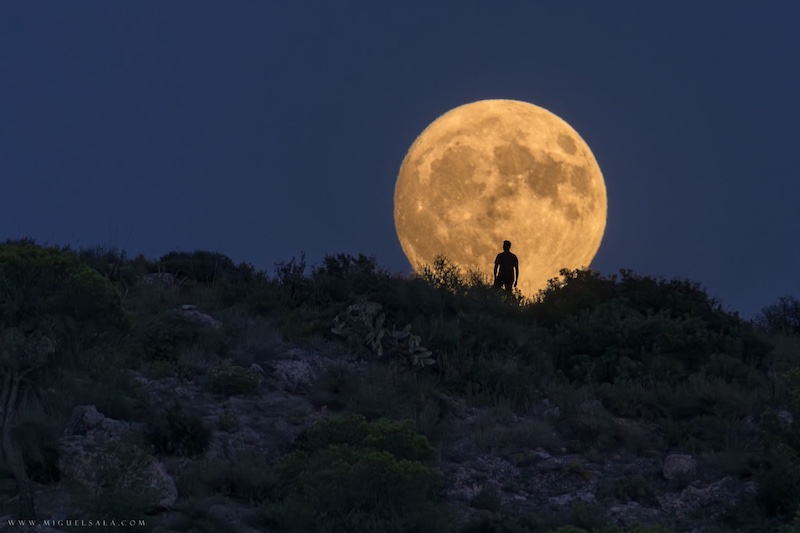
High tides from new and full supermoons
What’s more, all supermoons have the potential to cause higher-than-usual tides. High tides during the full or new moon are called spring tides. High tides during a full or new moon at perigee are called perigean spring tides, or, sometimes, king tides. And nowadays you sometimes hear them called supermoon tides.
These perigean or king or supermoon spring tides tend to follow the date of new or full moon by a day or so. These especially high tides are highly dependent on the shapes of local coastlines and on local weather conditions.
Do extra-high supermoon tides cause flooding? Maybe yes and maybe no. Flooding typically occurs when a strong weather system accompanies an especially high spring tide. According to Fred Espenak, the gravity from the closest supermoon is only 4% greater than the gravity from the moon at its average distance.
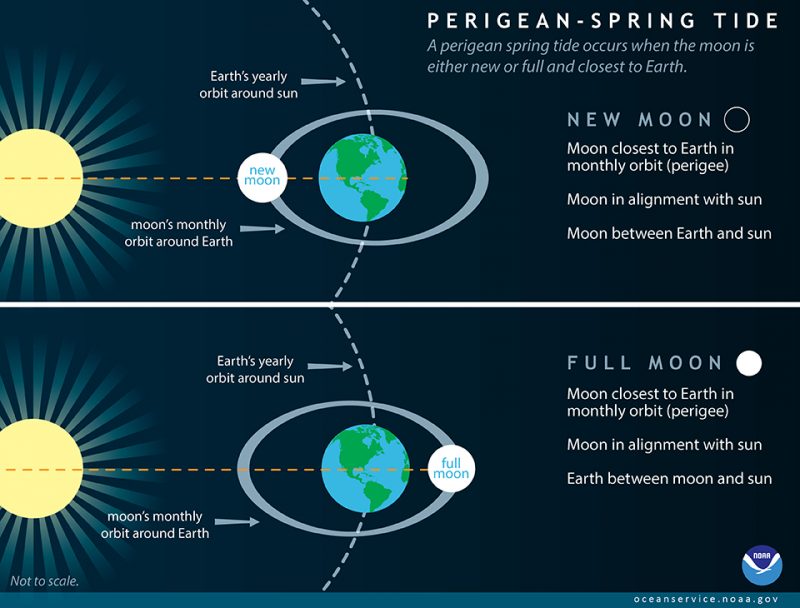
How often do we have a supermoon?
Often! But it also depends on your definition of supermoon.
Here’s a list of each year’s closest full supermoon perigees from 2016 to 2026 (from Espenak’s full supermoon table):
November 14, 2016 (356,523 kilometers or 221,533 miles)
December 3, 2017 (357,987 kilometers or 222,443 miles)
January 2, 2018 (356,604 kilometers or 221,583 miles)
February 19, 2019 (356,846 kilometers or 221,734 miles)
April 8, 2020 (357,035 kilometers or 221,851 miles)
May 26, 2021 (357,462 kilometers or 222,117 miles)
July 13, 2022 (357,418 kilometers or 222,089 miles)
August 31, 2023 (357,344 kilometers or 222,043 miles)
October 17, 2024 (357,364 kilometers or 222,056 miles)
November 5, 2025 (356,980 kilometers or 221,817 miles)
December 24, 2026 (356,740 kilometers or 221,668 miles)
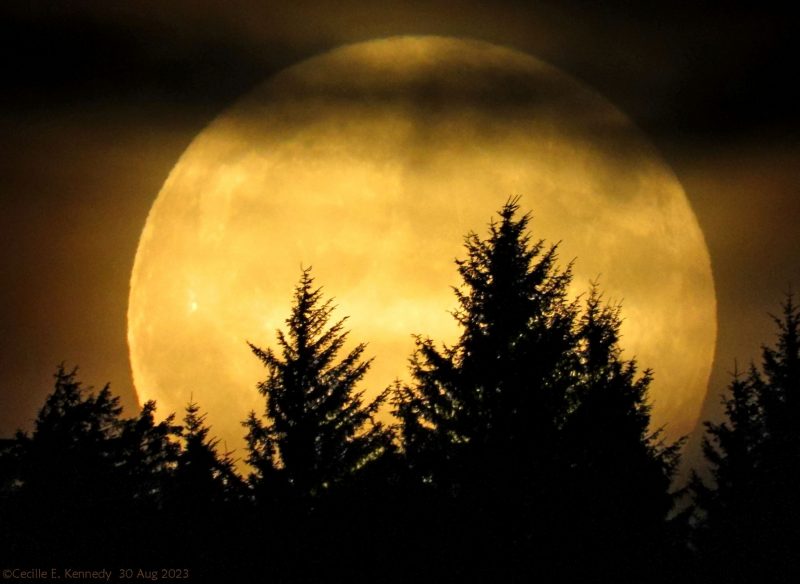
The recurring cycle of supermoons
The closest full moon supermoon in 2024 will recur after 14 lunar months (14 returns to full moon) after the closest full supermoon of 2023. That’s because 14 returns to full moon almost exactly equal 15 returns to perigee, a period of about one year, one month, and 18 days.
The mean lunar month (full moon to full moon, or new moon to new moon) = 29.53059 days, whereas the mean anomalistic month (perigee to perigee, or apogee to apogee) = 27.55455 days. Hence:
14 lunar months (14 returns to full moon) x 29.53059 days = 413.428 days
15 anomalistic months (15 returns to lunar perigee) x 27.55455 days = 413.318 days
So given that closest supermoon recurs in cycles of 413 days (about one year, one month and 18 days), we can expect the closest full moon supermoon to come about one month and 18 days later next year. Thus, the closest full supermoon of 2023 – August 31 – will be followed by the closest full supermoon 14 months later – October 17 – in 2024. The closest full supermoon of 2025 will be November 5, 2025.
The new supermoons of 2024 were:
Fred Espenak’s new supermoon table gives us these values – dates and moon distances – for new supermoons in 2024. Contrast these moon distances to the average moon distance of 238,900 miles (384,472 km).
Note dates are based on UTC time so some supermoons may fall on the previous date your local time.
Jan 11: 226,927 miles (365,204 kilometers)
Feb 09: 222,913 miles (358,744 kilometers)
Mar 10: 221,767 miles (356,899 kilometers)
Apr 08: 223,575 miles (359,809 kilometers)
May 08: 227,881 miles (366,739 kilometers)
The new supermoon of March 10, 2024, was the closest new supermoon for 2024.
And the new supermoon of April 8, 2024, was the moon that blocked out the sun causing a total solar eclipse.
Bottom line: What’ a supermoon? We had 5 new supermoons earlier in 2024. Now we’re about to have 4 full supermoons in a row.
Read more: Does a supermoon have a super effect on us?
Want to see 2023’s brightest supermoon? Photos here
The post What’s a supermoon? We’re about to have 4 in a row first appeared on EarthSky.
Just One Day Review
Alyson's story opens in Stratford-Upon-Avon, the birthplace of Shakespeare and the last stop in her crappy European tour/graduation present. When she takes a chance and sees an independant Shakespeare company, the next 48 hours of her life take a shocking twist. And so does she, as she says yes to things that she never would've before, because of Willem.
But what happens after?
Just One Day is a novel of love, both in the classic loving-a-boy way and in the not so classic finding-the-you-that-you-love way. Both of these story-lines were equally successful.
Alyson was a character that you found yourself rooting for no matter what, even when she was depressed and down on herself for stupid things. Dee-Dee was one of the funniest, most unique side characters I've found in a long while. And I found myself just as fascinated by Willem as she was.
Mammatus clouds are ominous and beautiful
Claire Glenn Atteberry@Kira Brooks - We talked about this.
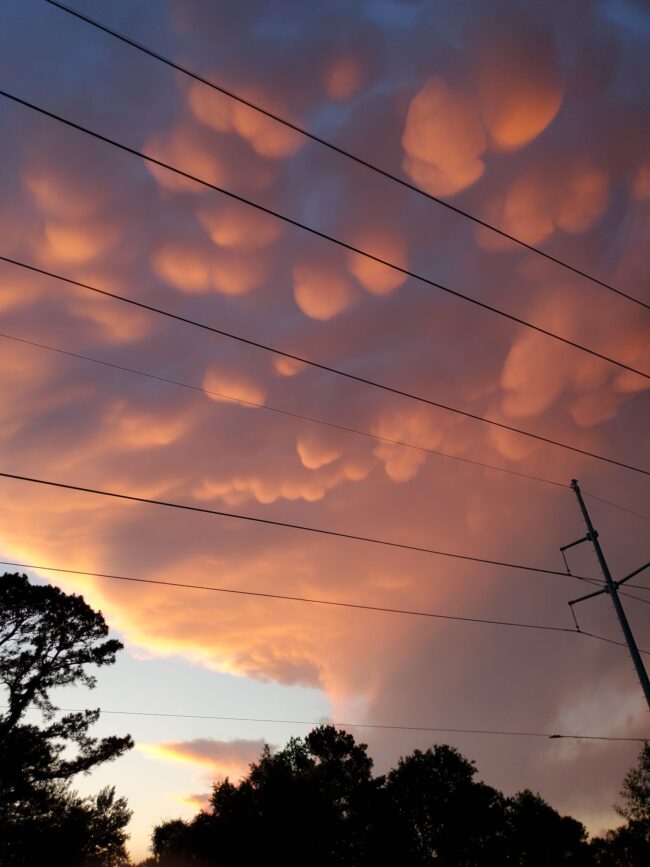
Mammatus clouds: Ominous and beautiful
Mammatus clouds are pouch-like protrusions hanging from the undersides of clouds. You’ll usually find them under thunderstorm anvil clouds. But you might see them under other types of clouds as well. They’re composed primarily of ices, and groups of them can extend hundreds of miles in any direction. But they’re fleeting, remaining visible in your local sky for perhaps 10 or 15 minutes at a time.
People associate these cloud pouches with severe weather. And it’s true; they typically appear around, before or after a storm.
In fact, most clouds are formed by rising air. But mammatus clouds are interesting in part because they’re formed by sinking air.
They appear ominous. And they do signify storms. But, in a way that’s so common in nature, their dangerous aspect goes hand-in-hand with a magnificent beauty.
Beautiful, bubbling clouds from 2023
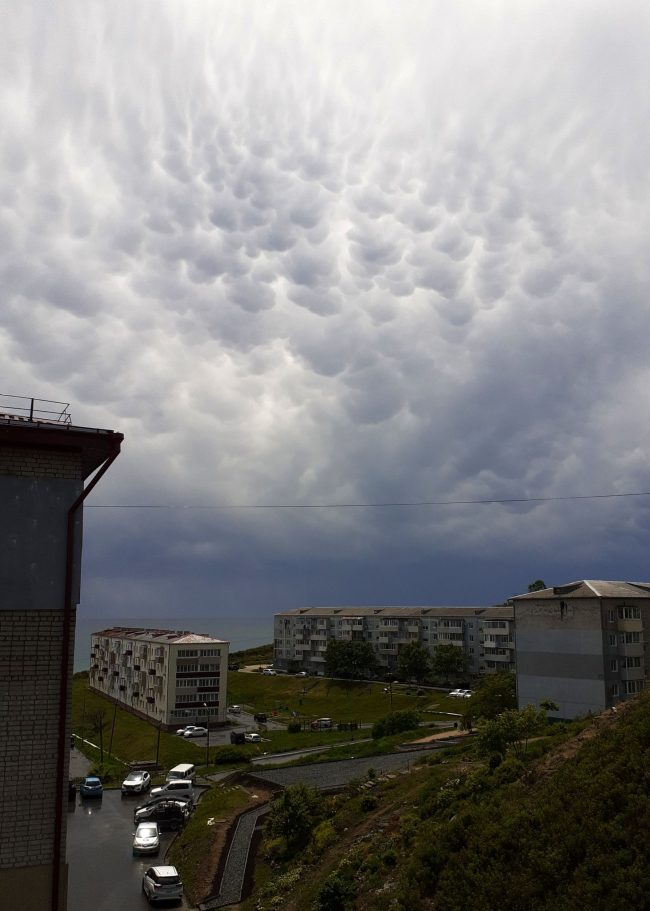
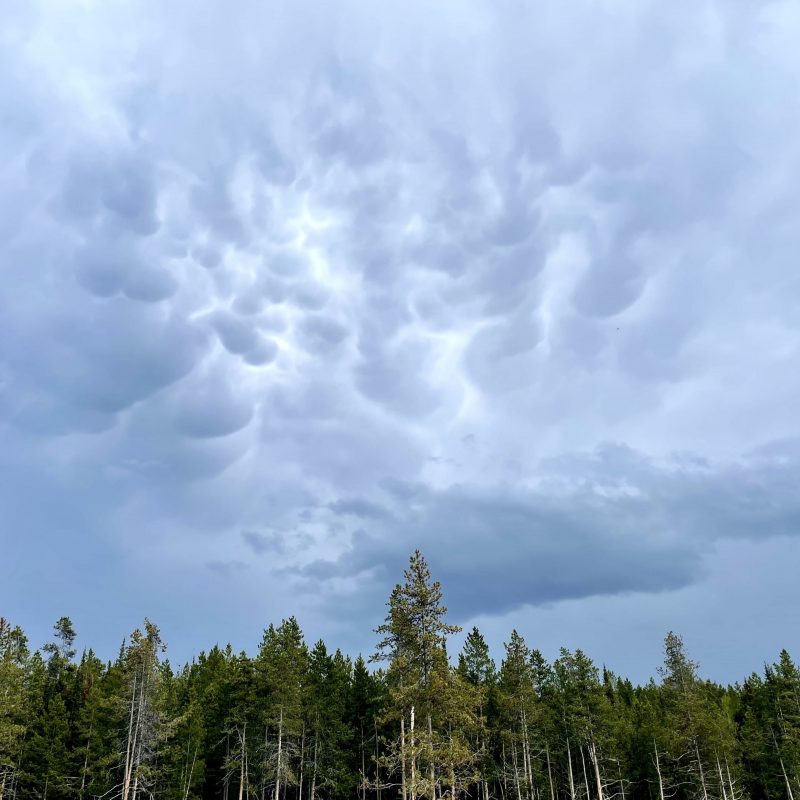
Mammatus clouds from 2022
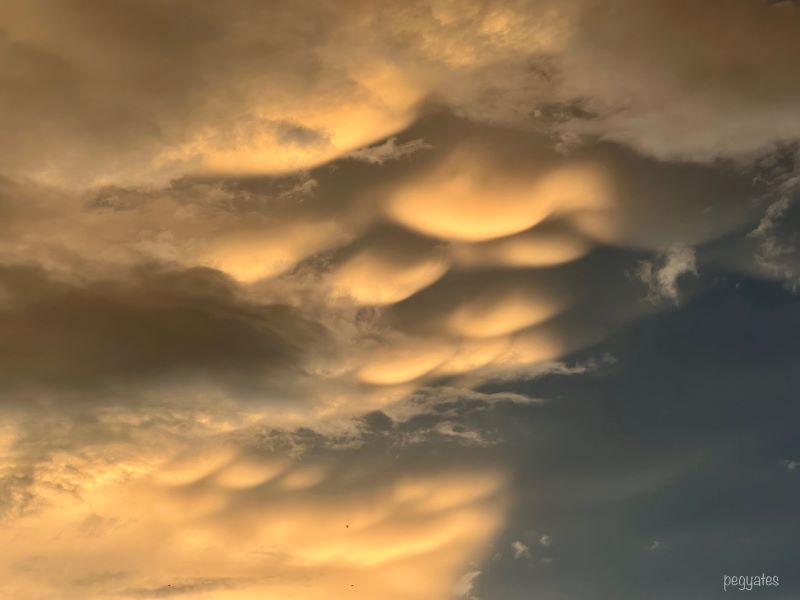
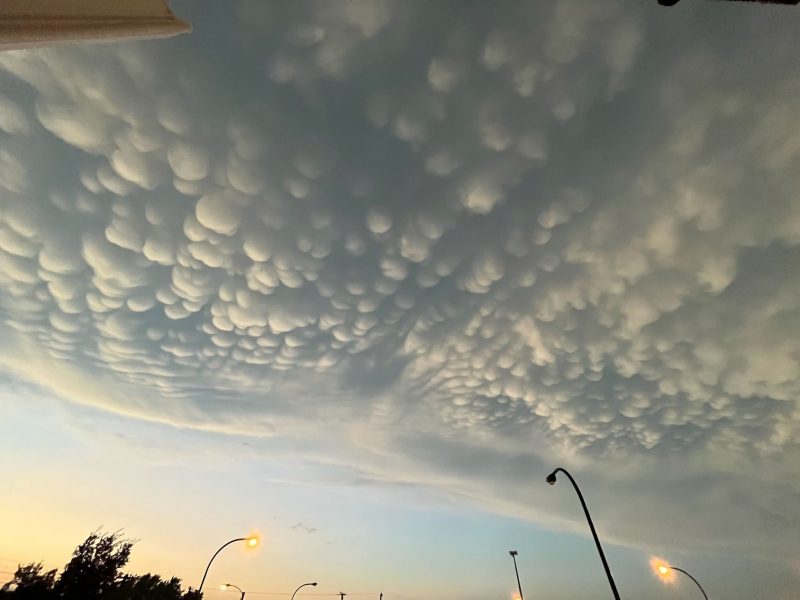
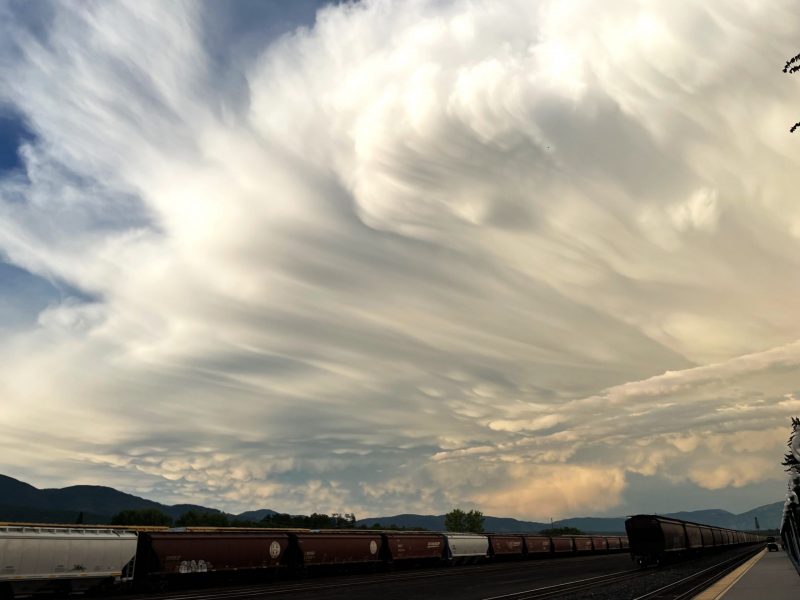
Mammatus clouds from 2021
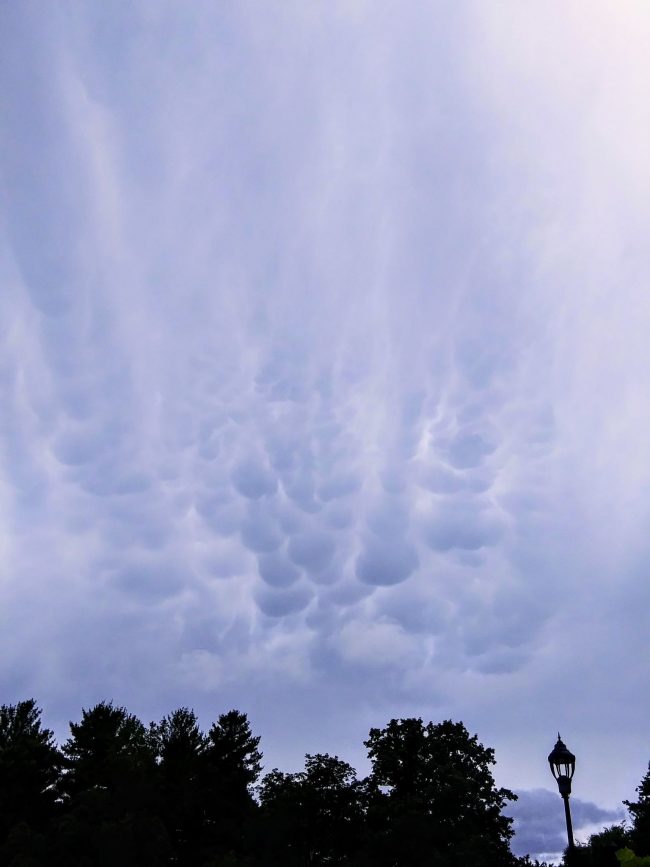
Images from 2020

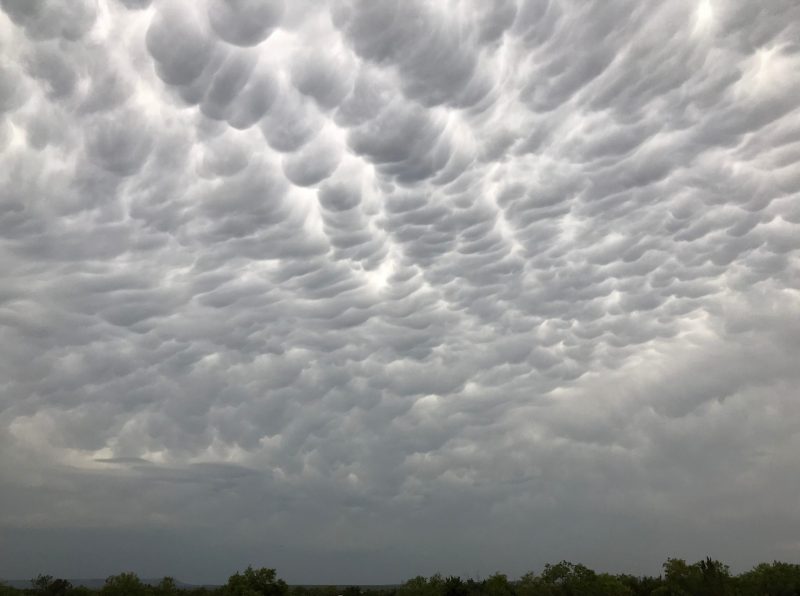
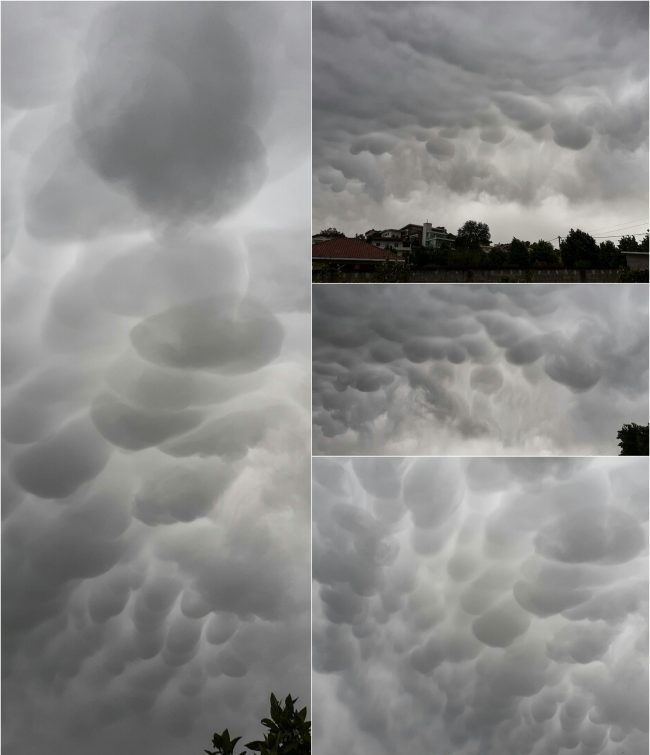
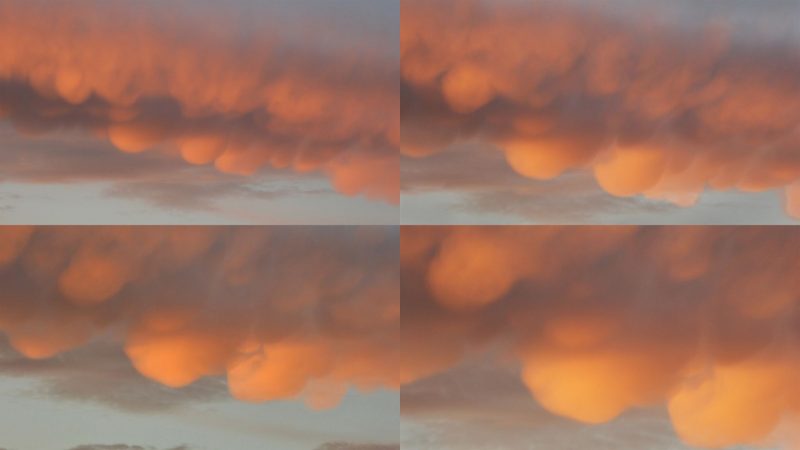
Bottom line: Mammatus clouds look like bubbling, low-hanging clouds. They’re often associated with thunderstorms. Learn more about them here and see photos.
The post Mammatus clouds are ominous and beautiful first appeared on EarthSky.
Happy super Hunter Moon!

Tonight – October 15, 2016 – the Northern Hemisphere’s full Hunter’s Moon ushers in the first of this year’s three full-moon supermoons, that is, full moons near perigee, or the moon’s closest point to Earth for the month. The November and December full moons will qualify as supermoons, too.
The image at top shows a micro-moon (small full moon) superimposed on supermoon (large full moon). This image – an Astronomy Picture of the Day – is from Stefano Sciarpetti.
The size difference of year’s largest and smallest full moons is comparable to that of a U.S. quarter and a U.S. nickel.
Will your eye see that the moon is bigger on the night of October 15? Well … it depends. For one thing, this October full moon is not the year’s largest full moon. That’ll be next month’s full moon, on November 14.
Also, it’s hard to judge the full moon’s size in our sky from one month to the next. 2016’s smallest full moon, sometimes called a micro-moon, happened on April 22. Since then, each following full moon has been incrementally closer to Earth. To notice a size difference between the smallest moon of 2016 in April – and the October 15 supermoon – you’ll probably need photographs of both moons, or some other way to quantify the difference.
There’s another complication to consider. All full moons appear especially large when they’re close to the eastern horizon after sunset. This effect is known as the moon illusion.
Are you an incredibly careful observer? Have you watched the full moon over a period of months, leading up to now? If so, says Daniel Fischer in Königswinter, Germany, you can discern the extra-large size of the supermoon using just your eye. Read Daniel’s article on this subject.
The ancients were well aware of the moon’s changing angular diameter and its varying distance from Earth. That’s because ancient astronomers used a diopter to directly measure the moon’s apparent diameter.
The November 14, 2016 full moon – closest and largest full moon is 2016 – will also be the largest full moon thus far in the 21st century (2001 to 2100). It’ll be the closest encounter between the Earth and moon until November 25, 2034! Read more about the November 14 supermoon.
Enjoying EarthSky so far? Sign up for our free daily newsletter today!
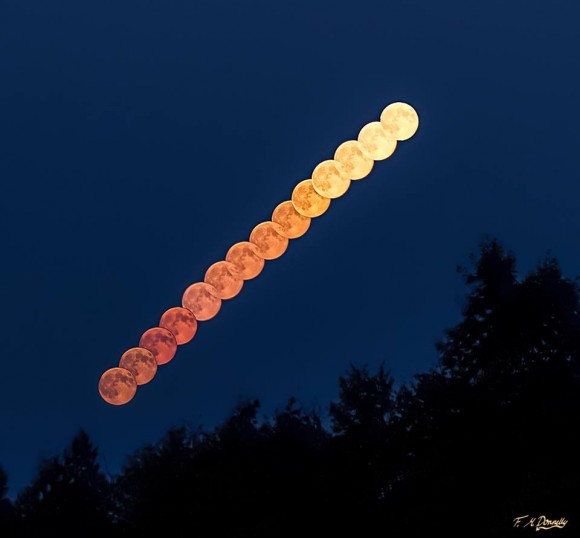
Super cool super-moonrise composite from Fiona M. Donnelly in Ontario. This was the supermoon of August, 2014.
Details on the October 2016 full supermoon The full moon falls at the same instant all over the world: October 16 at 4:23 Universal Time.
Clock time for this full moon – and every full moon – varies by time zone. For London, the moon turns full at 5:23 a.m. BST on October 16, at which time the moon shines in their western sky. For the U.S., the moon turns full on October 16 at 12:23 a.m. EDT – yet on October 15 at 11:23 p.m. CDT, 10:23 p.m. MDT and 9:23 p.m. PDT.
Technically speaking, the moon turns full at the instant that the moon lies opposite the sun for the month in ecliptic longitude. Because the moon stays more or less opposite the sun throughout the night, watch for a full-looking moon in the east at dusk, highest in the sky around midnight and low in the west at dawn. On the nights immediately before and after full moon, the moon still looks plenty full to the eye.
When is perigee, the moon’s closest point to Earth? In October 2016, the moon’s perigee comes about 19 hours after full moon, on October 16 at 23:36 Universal Time.
The close coincidence of full moon and perigee makes this October full moon a supermoon.
By the way, no particular effects are expected from this extra-close full moon … unless you have the mass of an ocean! In that case, gravity will come into play. In other words, because it’s a supermoon, and relatively close to Earth, this month’s full moon will pull harder than usual on Earth’s oceans. Expect higher-than-usual tides to follow this full moon by a day or so.
In the Northern Hemisphere, we call the full moon immediately following the Harvest Moon a Hunter’s Moon. This October 15, 2016 moon is the Northern Hemisphere’s Hunter’s Moon. Read more about the Hunter’s Moon here.
Enjoy moon-watching tonight and Sunday night!

Day and night sides of Earth at the instant of the October 2016 full moon (2016 October 16 at 4:23 Universal Time).

Lynne Pitts took this photo in New Hampshire on October 26, 2015. Lynne wrote, “Went to the lake to enjoy the sunset and the moonrise. Had a beautiful evening with soft colors and a spectacular moon.”
Bottom line: The full moon on the night of October 15-16 ushers in the first of three full-moon supermoons in 2016. Full moon is October 16, 2016, at 4:23 Universal Time. The moon’s perigee or closest point comes on October 16, at 23:36 Universal Time.
5.7-magnitude earthquake in northern California last night

The U.S. Geological Survey (USGS) reported a 5.7-magnitude earthquake in northern California last night (May 23 at 8:47 p.m. Pacific Daylight Time. The quake happened 113 miles (182 km) north-northeast of Sacramento, California. We are not seeing any reports of injuries or damages. Details of the quake below:
Event Time
2013-05-24 03:47:08 UTC
2013-05-23 20:47:08 UTC-07:00 at epicenter
2013-05-23 22:47:08 UTC-05:00 system time
Location
40.190°N 121.061°W
Depth=11.0km (6.8mi)
Nearby Cities
11km (7mi) WNW of Greenville, California
43km (27mi) SW of Susanville, California
60km (37mi) NE of Magalia, California
67km (42mi) NE of Paradise, California
159km (99mi) NW of Carson City, Nevada
More details about the May 23, 2013 California earthquake here.
A 4.9-magnitude quake struck a few hours later, just after 1 a.m. on May 24. Read about the aftershock here.
Bottom line: 5.7-magnitude earthquake and 4.9-magnitude aftershock in northern California on May 23-24, 2013.
Someone stop me
Yes, I realize I just published a new blog post 12 hours ago but I’m posting again because I just found a website that changes your fonts INTO CATS. Say goodbye to the rest of your week because…
Also, it’s Friday night and this is the highlight of my whole weekend.
I really need to get out more.
Reversal of the black widow myth

The Black Widow spider gets its name from the popular belief that female spiders eat their male suitors after mating. However, a new study has shown that the tendency to consume a potential mate is also true of some types of male spider. The study by Lenka Sentenska and Stano Pekar from Masaryk University in the Czech Republic finds that male spiders of the Micaria sociabilis species are more likely to eat the females than be eaten. The paper, published in Springer’s journal Behavioral Ecology and Sociobiology, outlines possible reasons for this behavior.
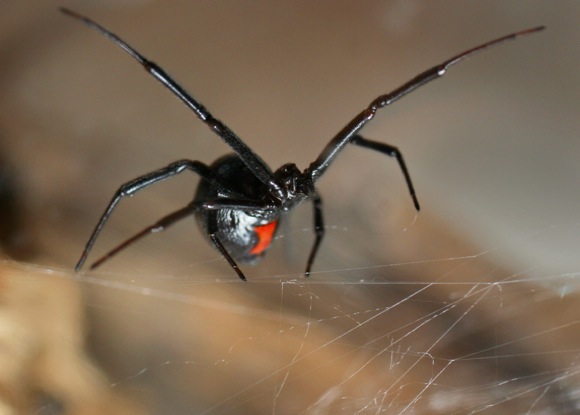
Closeup black widow spider showing hourglass marking. Credit: Shutterstock / Nate Alfred
In nature, female choice of mate is commonly seen as the overriding factor affecting male mating success. Sexual cannibalism is a form of female mate choice with low-quality mates more likely to be cannibalized. However, there is not as much evidence about how males may sometimes dictate the choice of partner. The researchers suggest that in the Micaria sociabilis species, reverse cannibalism seen may be a type of male mate choice.
The researchers collected male and female Micaria sociabilis spiders over a two-year period and studied their behavior by mixing males and females of the species at different time points. All spiders were well fed to discount cannibalism due to hunger. The authors observed what happened when they paired young adult male spiders with single female spiders either from the same generation (young female) or from another generation (old female). By pairing males with females of different size, age and mating status, the researchers hoped to be able to identify whether the reversed form of sexual cannibalism was an adaptive mechanism for male mate choice.
Their study found that cannibalism took place early after the first contact and before any mating took place. The researchers also observed that reverse cannibalism differed significantly, depending on what month it was – most of the incidences were in July. Males from the summer generation tended to be bigger than males from the spring generation and they were more cannibalistic. This would suggest that male aggression may be related to male size.
The authors noted that the highest frequency of reverse cannibalism occurred when these larger, young males from the summer generation met old females from the previous spring generation. This suggests they may have based their choice on female age. Female body size, even though considered to be a sign of quality, did not affect rates of cannibalism. The authors also noted no difference in male cannibalization of females who had previously mated or virgin females. This evidence demonstrates that in some species and some cases, the males make a very clear choice about who they will mate with.
The authors remark: “Our study provides an insight into an unusual mating system, which differs significantly from the general model. Even males may choose their potential partners and apparently, in some cases, they can present their choice as extremely as females do by cannibalizing unpreferred mates.”
Via Springer
This date in science: Mount Everest without supplemental oxygen
Claire Glenn AtteberryIn addition to yesterday being Fibonacci Day, there was this....

May 8, 1978. On this date, Reinhold Messner and Peter Habeler were the first to climb to the top of Mount Everest without supplemental oxygen.
Mount Everest is Earth’s highest mountain, with a peak at 8,848 meters (29,029 feet) above sea level. To climb Everest without supplementary oxygen means increased risk to the climber. Mount Everest near its summit can have weather extremes, deep cold and steep icy slopes. Quick, accurate decision-making may be needed. Without enough oxygen during the ascent, people cannot think clearly. At the summit itself, a person’s oxygen intake is less than one-third that at sea level.
Mount Everest climbing season curtailed after deadly accident
A closer look at the dangerous work that Everest’s Sherpas undertake for Western climbers

Reinhold Messner and Peter Habeler in 1978. Image via outdoorteam.at
Messner and Habeler’s first attempt at the summit without supplemental oxygen came on April 21, 1978. It went awry when, according to PBS, Habeler became violently ill from food poisoning at base camp from a can of sardines. Messner attempted the summit himself with two Sherpas, but was turned back by extreme weather.
Habeler and Messner tried again for the summit on May 6, 1978, but only after arguing over whether the exploit was worth it. They arrived safely on May 8, but they admitted the ascent without extra oxygen took almost everything out of them. Messner later described the experience this way:
Breathing becomes such a strenuous business that we scarcely have strength left to go on. Every ten or fifteen steps, we collapse into the snow to rest, then crawl on again. My mind seems almost to have ceased to function. I simply go on climbing automatically. The fact that we are on Everest, the highest mountain in the world, is forgotten – nor does it register that we are climbing without oxygen apparatus.
He described a “state of spiritual abstraction” at the summit, later writing:
I no longer belong to myself and to my eyesight.
I am nothing more than a single narrow gasping lung, floating over the mists and summits.
The two had built up experience before Everest by climbing several other tall mountains without oxygen: Matterhorn, Eigerwand and Gasherbrum. Though their exploits got concern from the medical community, they were determined to ascend the world’s tallest peak without oxygen. And they did.

Mount Everest as seen from Base Camp 1. Photo credit: Rupert Taylor-Price/Flickr

Photo by Niranjan Shrestha via newyorkdailynews.com
Mount Everest climbing season curtailed after deadly accident. In recent weeks of 2014, there has been an exodus of climbers from Mount Everest, after Sherpas refused to climb out of respect for 16 Nepalese guides who died in a deadly avalanche on April 18, 2014.
Throughout the history of climbing Everest, virtually everyone who reaches the summit does so with supplemental oxygen, and the practice of carrying extra oxygen has intensified in recent years as more people have adding climbing Mount Everest to their “bucket lists.” Virtually all westerners who ascend to the top of Everest use oxygen masks and tanks above 8,000 meters (26,000 feet). Some even use oxygenated tents. All of this gear is carried by Sherpas.
The video below shows the harrowing footage of the April 18 avalanche near Everest Base Camp, which killed 16 people. As of late April, three of bodies remain buried in ice and snow on the mountain.
Scientists say that climbing Mount Everest and similarly high mountains on Earth may become more difficult as global climate warms, making glacial ice at high altitudes less and less stable.
Bottom line: May 8, 1978 marks the first ascent of Mount Everest without supplemental oxygen, a feat accomplished by Reinhold Messner and Peter Habeler.
Flying squirrels reunited after 20 years with new road crossing
Claire Glenn Atteberry@Original Kim - Cuteness!

In 2008, biologists installed crossing structures to help endangered Carolina northern flying squirrels glide across a road. The road was blocking the ability of the squirrels to access mates, den sites and foraging grounds in the forests of North Carolina. Now, new research suggests that the road crossings are working—squirrels were observed using the crossing structures 14 times over the past few years. The research was published on February 28, 2013 in the Wildlife Society Bulletin.

Carolina northern flying squirrels are small nocturnal squirrels that are most active at night. While the squirrels cannot fly, they do glide through the air using the aerodynamic lift provided by a fold of their skin that stretches from their wrists to ankles. When gliding, the squirrels use their broad flat tails as a rudder to steer. Carolina northern flying squirrels are an endangered species that inhabit cool, moist forests in North Carolina, Tennessee and Virginia. Their populations are highly fragmented into only a few forest habitats.
In 2002, biologists noticed that Carolina northern flying squirrels were not crossing over a two-lane road located along a scenic stretch of highway in North Carolina’s Unicoi Mountains. Flying squirrels use tall trees to launch into a glide, and they typically can glide for about 5 to 25 meters (16 to 82 feet). The gap created by the road and the treeless area along the shoulder averaged about 38 meters (125 feet), which was too large for most squirrels to leap across. Not being able to cross the road was hindering the ability of the squirrels to access mates, den sites and foraging grounds in forest habitats throughout the region.
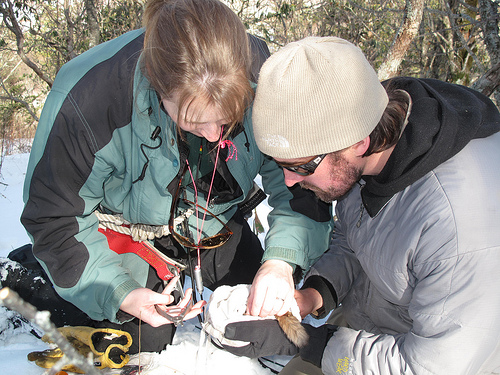
Biologists Chris Kelly and Mike LaVoie tag a Carolina northern flying squirrel. Image Credit: Gary Peeples, US Fish and Wildlife.
Inspired by an Australian study that successfully used artificial structures to assist flying squirrels in navigating across road barriers, biologists from the North Carolina Wildlife Resources Commission and North Carolina State University installed three pairs of crossing poles along the road in North Carolina. The crossing poles were situated about 14 meters (46 feet) above the ground and they had a long horizontal platform attached to serve as a launching spot. Each crossing pole was spaced at distance of approximately 15 meters (49 feet) apart from another pole on the opposite side of the road. For 15 months in 2009 and 2010, the biologists monitored the road to see if the flying squirrels were using the platforms.

Image credit: Savage/San Francisco State University
Findings from the study showed that squirrels were successfully using the new crossing structures. Squirrels were observed on camera leaping off the platforms 14 times during the study (you can view a video here), and radio-collared squirrels were found to be using habitat on opposite sides of the road from where they were first caught and tagged. The biologists are hoping that squirrels will continue to increase their use of the crossing structures over time.
Reconnecting the isolated populations of endangered northern flying squirrels may help to prevent this species from going extinct.
Authors of the study included Christine Kelly, Corinne Diggins and Andrew Lawrence.
Bottom line: Biologists from the North Carolina Wildlife Resources Commission and North Carolina State University installed crossing structures to assist endangered Carolina northern flying squirrels to navigate across a road barrier. They observed the squirrels successfully using the road crossings and they are hoping that the structures will help to improve the access of the squirrels to new mates, den sites and foraging grounds. Their research was published on February 28, 2013 in the Wildlife Society Bulletin.
Happy May Day! Today is an astronomy holiday
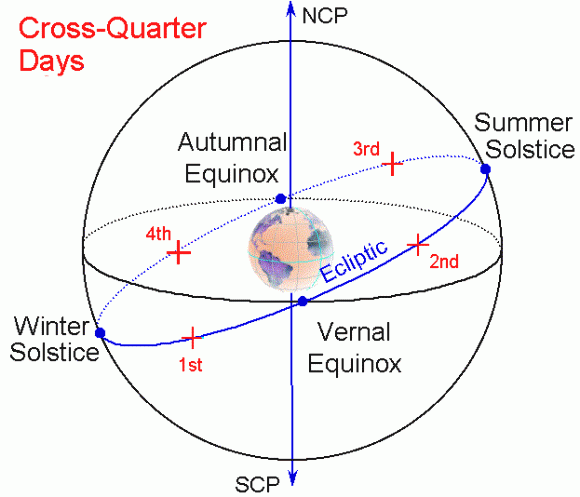
May Day is May 1
You might not realize it, but May Day – an ancient spring festival in the Northern Hemisphere – is an astronomy holiday. It’s one of the year’s four cross-quarter days. That is, it’s a day that falls more or less midway between an equinox and solstice. In this case, it’s between the March equinox and June solstice.
The other cross-quarter days are Groundhog Day on February 2, Lammas on August 1, and Halloween on October 31.
May Day also stems from the Celtic festival of Beltane. It was related to the waxing power of the sun as we in the Northern Hemisphere move closer to summer. At Beltane, people drove livestock through lit fires and people danced around them. They were all moving in the same direction that the sun crosses the sky.
In Hawaii, May Day is Lei Day, a statewide celebration of the aloha spirit and the giving of the flower lei.
May Day and maypoles
Of course, wrapping a maypole with colorful ribbons is perhaps the best known of all May Day traditions. In the Middle Ages, English villages all had maypoles. They were part of the rejoicing and raucous merrymaking of May Day.
Maypoles came in many sizes. And there was competition among the villages to show whose maypole was the tallest. In small towns, maypoles were usually set up for the day. But they were erected permanently in London and the larger towns.
Here’s a WikiHow on how to do a maypole dance


May baskets can brighten someone’s day
We’re not too far away from a time in the late 20th century when people left homemade May baskets filled with spring flowers and sweets on others’ doorsteps, usually anonymously. I can remember doing this as a child. Maybe it’s a tradition that can be revived.
I love this for a May craft for kids! #maydayhttps://t.co/00NGF4L1I8
— HomeschoolSuperFreak (@HSSuperFreak) April 18, 2023
Bottom line: May 1 is one of four cross-quarter days, midway between an equinox and a solstice. So, happy May Day 2024!
Read more: Halloween is a cross-quarter day
Read more: Groundhog Day is an astronomy holiday
The post Happy May Day! Today is an astronomy holiday first appeared on EarthSky.
May birthstone is the emerald

The May birthstone is the emerald
The emerald belongs to the beryl family of minerals. It also includes aquamarine (one of March’s birthstones), heliodor, and morganite. Beryl, or beryllium aluminum silicate in chemical jargon, is a six-sided symmetrical crystal. Additionally, Beryl contains beryllium, aluminum, silicon, and oxygen.
Emeralds vary in color from light to deep green. It’s commonly thought that an emerald’s color derives from the presence of chromium and/or vanadium replacing some of the aluminum in the mineral’s structure. However, the stone can lose its color when heated strongly.
Mineralogy of emeralds
Emeralds are most frequently found inside a form of shale – a fine-grained sedimentary rock. Emerald-bearing shale has undergone recrystallization caused by changes in the physical environment such as pressure and temperature. Colombia produces the largest and highest quality emeralds. Around 1830, they found and began mining emeralds in the Ural Mountains of Russia. Also, North Carolina – in the United States – is a source for emeralds. Around the world, they also occur in Zambia, Brazil, Pakistan, Norway, Austria, India, Madagascar, and Australia.
German chemists began making synthetic emeralds shortly before World War II. Then, growing synthetic stones of fine quality began in the United States in 1946. Also, there are excellent imitation emeralds on the market made of colored cut glass.
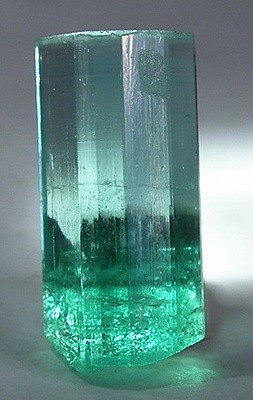
History of emeralds
The emerald’s name derives from the Greek word “smaragdos,” a term applied to several kinds of green stones. Plus, knowledge of emeralds date back to antiquity. Royalty wore them in Babylon and Egypt. As a matter of fact, emerald mines of Egypt had tools dating back to 1300 B.C., during the reign of Ramesses II. Queen Cleopatra’s emeralds probably originated from mines in southern Egypt, near the Red Sea.
When the conquistadors first arrived in South America from Spain, they saw indigenous rulers wearing emeralds. Then they stole large quantities of emeralds from the Peruvians during the invasion. But they never discovered the source of the emeralds. Then in 1537, the Spaniards found Chivor in Colombia, now the location of an important emerald mine. They also took over the Muzo mine following the defeat of the Muzo Indians. Mining operations at Muzo have continued almost uninterrupted since the Spanish invasion. It is perhaps the most famous emerald mine in Colombia and produces the world’s best emeralds.
Lore of the green May birthstone
Several famous historical artifacts contain emeralds. Among them is the Crown of the Andes, made from emeralds worn by Atahualpa, the last Inca (king) of Peru. The crown is set with about 450 emeralds, collectively weighing 10 ounces (1523 carats).
There are many myths associated with the emerald. It’s believed to prevent epilepsy, stop bleeding, cure dysentery and fever, and protect the wearer from panic. Plus, its magnificent green color could rest and relieve the eye. Additionally, the ancient Romans, dedicated emeralds to the goddess Venus because the green emerald symbolized the reproductive forces of nature. Also, early Christians saw it as a symbol of the resurrection of Christ. Then in the Middle Ages, they thought emeralds had the power to foretell the future.
Find out about the birthstones for the other months of the year
January birthstone
February birthstone
March birthstone
April birthstone
May birthstone
June birthstone
July birthstone
August birthstone
September birthstone
October birthstone
November birthstone
December birthstone
Bottom line: For those born in May, the May birthstone is the emerald, a type of beryl colored green by chromium. Perfect emeralds are among the rarest of all gemstones.
The post May birthstone is the emerald first appeared on EarthSky.
Moms Love Handmade Cupcake Liner Flowers
Claire Glenn Atteberry@Rhonda Shock - @Great Beginnings
Moms love anything handmade by their kiddies. That goes for these cute cupcake liner flowers as well. I happen to know Grandmas love them too. So you might want to craft up a few of these with the kids and gift them to a mother you know, letting them know they’re loved.

Supplies for Cupcake Liner Flowers:
- cupcake liners – 3-6 per flower
- pipe cleaners – 1 per flower
- scissors
- cute washi tape vase
First choose what your flowers will be. Pick out your colors and how many liners you’d like for each.

Pattern Method:
Fold each of your cupcake liners in half.

Layered Method:
Keep your liners in their shape and layer them into the stem.

To Make the Flowers:
1. Fold your pipe cleaner in half and twist it up. The twisting helps keep it a little more sturdy as you add the liners.

2. Once you’ve chosen your liners, use the sharp ends of your pipe cleaners to pierce a hole into the center of each liner.
3. Add as many liners as you’d like.
4. Roll up your pipe cleaner one turn for the inside of the flower, helping your liners stay in place.

Now add them to your vase or wrap them with ribbon and they are ready for giving.

Happy Mother’s Day!
Video: Honeybee in ultra slow motion

This is cool. And perfect for springtime. Part of the Flightartists Project, this video shows a honeybee as it starts its flight after collecting nectar, filmed with a high speed camera at 3000 frames per second.
Bee in ultra slow motion from Joris Schaap on Vimeo.
Scientists say that the secret of honeybee flight is a combination of short, choppy wing strokes, a rapid rotation of the wing as it flops over and reverses direction, and a very fast wing-beat frequency. Wing-beat frequency normally increases as body size decreases, but as the bee’s wing beat covers such a small arc, it flaps approximately 230 times per second, faster than a fruitfly (200 times per second) which is 80 times smaller.
Milky Way over Crater Lake
Claire Glenn AtteberryBeautiful!

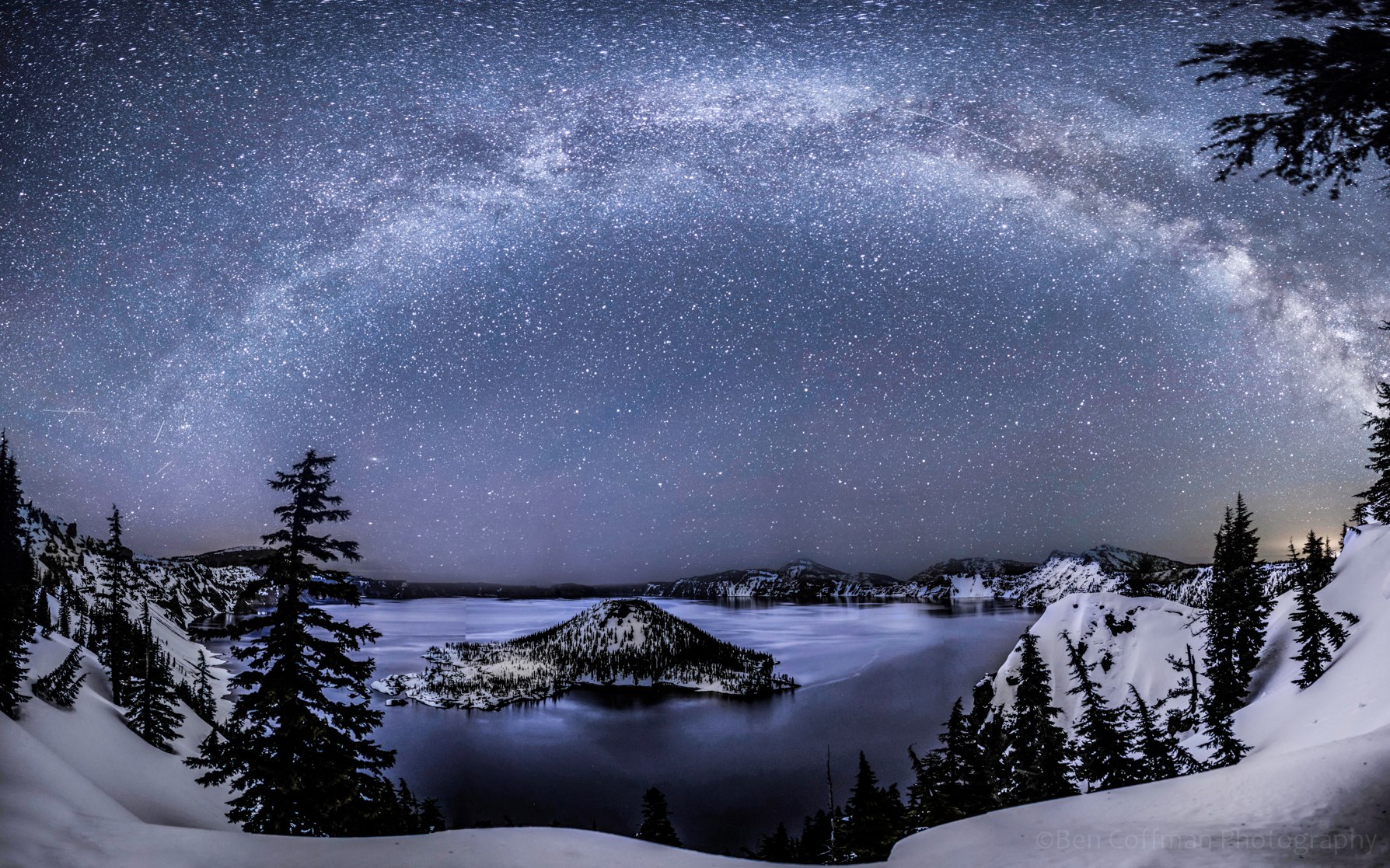
Milky Way over Crater Lake captured by our friend Ben Coffman Photography on April 20, 2013, during the Lyrid meteor shower. View larger. Thanks Ben! Visit Ben Coffman Photography on Facebook.
Ben Coffman Photography captured this beautiful photo of the Milky Way over Crater Lake in Oregon. He wrote:
Hi, Earthsky, I wanted to share this panorama of the Milky Way over Crater Lake that I took Saturday night. You can see a few Lyrids in the photo (3 small ones on the left, in the Milky Way, and one larger one in the top right of the Milky Way). Andromeda can be seen near the tree to the left. Thanks for taking a look!
Visit the official website of Crater Lake National Park
Want to see your images featured on EarthSky? Send us your great photos via EarthSky on Facebook, EarthSky’s photo community on Google+, and/or e-mail: images@earthsky.org.
{old cooks’ tales} Allow Me to Debunk 10 Common Food and Cooking Myths Using Science, Facts, & Common Sense
There are so many nonsensical myths about food and cooking that people trot out, and I’m not going to lie: they make me a little grumpy. They are awful and they are persistent and they need to stop. I reached my limit this week when I saw a viral Pinterest post about how to tell whether a bell pepper was male or female.
Once I was done shaking my head at the sheer inanity of it all, I decided to arm myself with (some) science and facts and a liberal dose of common sense to explain why some of these common food tropes are as mythological as unicorns, leprechauns, or free parking in San Francisco.
10 Common Food and Cooking Myths DEBUNKED Using Science, Facts, & Common Sense
1. Bell peppers are “male” or “female.” Females have 4 bumps and fewer seeds and are sweeter than male peppers when eaten raw. Male peppers have only 3 bumps and are better for cooking.
Just, no. Bell peppers are hermaphrodites. Different varietals of peppers look different and taste different but it has nothing to do with boy peppers and girl peppers. Seriously, this is so stupid.
2. If you make your soup too salty, put a peeled potato in it to absorb the salt.
This is one of the most common of these idiotic myths. Have you ever tried this? Has anyone? What if I made something else too salty; does it only work for soup? Is this a common problem? Are we all constantly putting too much salt in our soup? How do you know I have an “emergency potato” lying around? What if you don’t want to cook the soup another 30 minutes?
But I digress: beyond my issues with the usefulness of this tip, let’s talk about whether it actually works. Of course the potato will suck up some of the salt but will it suck up enough to make any noticeable difference in the taste of the soup? No, it will not. Here is a science-y experiment showing it doesn’t work. Why wouldn’t you just, like, add more broth or water or something? Or something to counteract the salt, like a little acid or a little sweetener? What the hell?
3. You have to sear meat to “keep the juices in.”
This is the myth I find to be the most personally irksome because it’s been disproven like a bazillion times but people still believe it. Does searing meat make it taste better? Yes, because of the flavor and aroma enhancement that occurs, known as the Maillard Reaction. Does it “keep the juices in?” No, it does not. If you don’t believe me, then consummate food scientist and anti-searing-myth crusader Harold McGee is going to tell you why in this video.
4. Agave syrup is a healthy/natural/superior sweetener.
Sorry, no. I fell for this for awhile but unfortunately, agave syrup is pretty much made in the same way that high-fructose corn syrup (HFCS) is made except instead of using corn as a starch base to suck out a whole bunch of sugar artificially, they use the starchy root of the agave plant. Except that in the case of agave, it tends to have even MORE fructose than HCFS – up to 90% in agave syrup as compared to HFCS’s 55%. There are like a million articles about this, here is one to start with, and here is another one I like. (As a clarifying point, there is a less widely available product out there called miel de agave or miel de maguey that is boiled sap from the agave leaves and is, I guess from some perspectives, healthy/natural/superior, but I am not talking about that.)
5. Cashews are nuts.
OK, so this isn’t really a common myth, per se, but a lot of people don’t know this and it’s really weird so I’m including it. Cashews are not nuts, they are formed as a single seed attached to an “accessory fruit” called a cashew fruit or a cashew apple, as seen in the above photo. They look like little turds that hang off the bottom of the fruit. Their shells are poisonous. In other countries, they actually eat the fruit too. That is all I know about cashews.
6. If you get sick at a picnic, blame the mayonnaise.
This statement is 100% true if you make your own mayonnaise from raw eggs. But if you are talking about the Best Foods/Hellman’s variety of mayonnaise, it is totally untrue. Store-bought mayonnaise is an incredibly inhospitable environment for bacteria to grow in. It’s acidic, it’s fatty, it’s salty, I mean seriously, it’s like the opposite of a petri dish. It’s actually been shown to kill bacteria. But, people often blame the mayo for becoming sick because it looks and smells gross after it’s been sitting out for awhile. The tuna/chicken/potatoes that are in that dish are really fantastic places for bacteria to fester and divide, but they don’t always look and smell gross. So stop blaming the mayo and take a closer look at the other ingredients. Here is a deeper explanation with citations to back this up.
7. Egg yolks are unhealthy so you should just eat the egg whites.
Egg whites have garnered a reputation for being super healthy, but the yolk is where all of the positive nutrients of the egg reside. Unless you are on a calorie restrictive diet, just eat the whole damn egg. A whole egg only has like 50 more calories than an egg white and all the stuff that’s good for you – including choline, lutein, and a bunch of other stuff you need for your brain, your heart, your eyes, and more. They don’t raise your bad cholesterol or cause heart disease.
Also, egg whites on their own are soooo grosss. (Note: last point is admittedly not science or fact.)
8. Microwave lemons and limes before juicing them to get the most juice.
Who has time for this? And won’t that make my lemons warm? Are your lemons too cold? How did they get cold? Aren’t they just out on the counter in a bowl like my lemons? WHAT ARE YOU DOING TO YOUR LEMONS?
But seriously, do warm lemons have more juice? No – if anything, heat makes liquid evaporate (bye bye liquid), not spontaneously generate an abundant flow like a citrusy, juicy Phoenix from the hallowed corners of the microwave. Does it make them easier to juice? Well I tried it and got the same amount of juice from each lemon, but with a few minor differences: with the microwaved lemon I wasted some time heating and cooling it, and felt pretty silly.
From a purely common sense perspective, is it possible, even if this worked, that microwaving a lemon could really make such a huge difference in how much juice you appreciably get out to make it worth doing? Is there some post-apocalyptic-lemon-shortage scenario for which I should mentally store this great idea, because dammit, we’ll need every drop?
But that doesn’t actually matter, because it doesn’t work anyway. Just get one of these and you’ll get enough juice out.
9. Nuts are fattening.
Yes, nuts are high in calories, but being high in calories and being fattening are not the same. Interestingly, studies have shown that people who regularly eat nuts actually weigh less than their nut-free counterparts. This is a correlation, not a cause and effect, so I’m not suggesting that adding nuts to your diet will help you lose weight, but I am saying that they are therefore not “fattening.” I wrote an article about this which is full of scientific citations so feel free to check that out for the links.
10. Cook octopus with a cork in the pot to make it more tender.
I just can’t even begin to talk about how ridiculous this is. But I will try. Even chefs who swear by this can’t say why they think it works. And no, corks do not have “enzymes” in them that tenderize octopus, which exemplifies the type of eye-popping “factoid” about this topic I found smeared liberally across the Internets. Perhaps they are hoping that they infinitesimal trace amounts of tartaric acid on the cork will sink into the pot and make the octopus tender – but what about, instead, if you just added some actual tartaric acid (cream of tartar) instead of a frigging cork? And really, are you drinking such well-aged, high-end wine that your corks pop out covered in crystals?
Deep breaths, in and out.
If you have any myths you’re wondering about, or would like to share, add them in the comments!
Unique chemistry reveals eruption of ancient materials once at Earth’s surface

An international team of researchers, including Scripps Institution of Oceanography, UC San Diego, geochemist James Day, has found new evidence that material contained in oceanic lava flows originated in Earth’s ancient Archean crust. These findings support the theory that much of the Earth’s original crust has been recycled by the process of subduction, helping to explain how the Earth has formed and changed over time.

Flow of red hot lava. Credit: Shutterstock / Alexey Kamenskiy
The Archean geologic eon, Earth’s second oldest, dating from 3.8 to 2.5 billion years ago, is the source of the oldest exposed rock formations on the planet’s surface. (Archean rocks are known from Greenland, the Canadian Shield, the Baltic Shield, Scotland, India, Brazil, western Australia, and southern Africa.) Although the first continents were formed during the Archean eon, rock of this age makes up only around seven percent of the world’s current crust.
“Our new results are important because they provide strong evidence not only to tie materials that were once on Earth’s surface to an entire cycle of subduction, storage in the mantle, and return to the surface as lavas, but they also place a firm time constraint on when plate tectonics began; no later than 2.5 billion years ago,” said Day. “This is because mass independent sulfur signatures have only been shown to occur in the atmosphere during periods of low oxygenation prior to the rise of oxygen-exhaling organisms.”
The new study, which will be published in the April 24 issue of the journal Nature, adds further support to the theory that most of the Archean crust was subducted or folded back into the Earth’s mantle, evidence of which is seen in the presence of specific sulfur isotopes found in some oceanic lava flows.
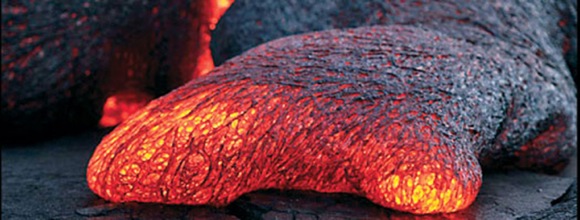
Credit: UC San Diego
According to the researchers, because terrestrial independently fractionated (MIF) sulfur-isotope isotope signatures were generated exclusively through atmospheric photochemical reactions until about 2.5 billion years ago, material containing such isotopes must have originated in the Archean crust. In the new study, the researchers found MIF sulfur-isotope signatures in olivine-hosted sulfides from relatively young (20-million-year-old) ocean island basalts (OIB) from Mangaia, Cook Islands (Polynesia), providing evidence that the mantle is the only possible source of the ancient Archean materials found in the Mangaia lavas.
“The discovery of MIF-S isotope in these young oceanic lavas suggests that sulfur—likely derived from the hydrothermally-altered oceanic crust—was subducted into the mantle more than 2.5 billion years ago and recycled into the mantle source of the Mangaia lavas,” said Rita Cabral, the study’s primary author and a graduate student in Boston University’s Department of Earth and Environment.
The data also complement evidence for sulfur recycling of ancient sedimentary materials to the subcontinental lithospheric mantle previously identified in diamond inclusions.
Via UC San Diego
Video: Science of cats
Claire Glenn Atteberry@Rebekah Ellysse - for you!

Cats are mysterious to some, and beloved by many, and if you spend any time at all the on the Internet you know … the Internet loves cats. Here’s a video from ASAPscience that explains the science of cats.
A Lesson in Juicing

So, I quite like my juicer(!), and I love the possibilities it lends to expanding my overall ingredient/culinary palette. Fresh juice is invigorating - straight up, blended, or as part of whatever I'm making. The most important thing is to use vibrant, healthy produce. Use the best quality produce you can get. It's important to seek out organic or sustainably grown fruits and vegetables, but if that's not happening, wash it gently, but thoroughly.
A few observations: A blender and a juicer are entirely different beasts. I know this seems obvious, but the blender does chop-chop, and the juicer separates all the fibers and solids from the juices. The juicer produces essences that are incredibly intense, alive, and bright. The flavor is main-lined. Beyond fruits and vegetables, I experiment with grains and nuts (see below).
Everyone seems to think using a juicer is a royal pain. Primarily the clean-up part. And that is partially true. It seems most convenient to juice in batches, set aside what you might use in the immediate future as well as the forthcoming day or two, and then freeze any juice beyond that immediately. Not as perfect as freshly juiced, but still ok.


One thing I'll add here, read you juicer's instructions before diving in. What works in mine might not work in your model. There are a range of different types of juicers, and a range of ways they extract juice.
Almond Milk: Soak 1 cup / 5 oz almonds overnight, covered, in filtered water. Drain. Add three cups water, and ladle into juicer. This produces a full-bodied almond milk. If you like it a bit thinner, go with 4 cups water. The flavor really sings when you season it with a touch of salt and sugar. Just go with your taste buds, until it tastes good to you. Makes about 3 1/2 cups. Also, be sure to keep the meaty by-product of making the almond milk, just scrape it out of the juicer. Salt it a bit, and it's a great homemade almond butter.
Oat Milk: Soak 1 cup / 3 oz rolled oats (not instant) overnight, covered, in filtered water. Drain, add 3 cups water, and ladle into juicer. Makes about 4 cups. Note to self to try a version with toasted oats. I could imagine experimenting with it as and ingredient in custards, puddings, french toast, and the like.
Pistachio Milk: Soak 1 cup pistachios / 5 oz overnight, covered, in filtered water. Drain, combine with 3 cups water, and ladle into juicer. This was my favorite non-fruit juice by a stretch. Really nice. I kept trying to combine it with little accents like orange blossom water, or citrus zest, but in the end I liked it best straight. Makes about 3 1/2 - 4 cups. And like the almond milk be sure to keep the meaty by-product of making the pistachio milk, just scrape it out of the juicer. Salt it a bit, and it's a great pistachio butter.
Sesame Milk: Had high hopes for this one but it really didn't work. The unhulled seeds never broke down in the juicer.


Fennel Juice: Trim the root end, but use all the rest of it. 1 large bulb = ~1 cup juice.
Celery: Lob off the root end and use the rest. And I didn't bother restringing. 1 medium bunch = 1 1/2 - 2 cups juice. I'm enjoying using the celery juice as a component in all things brothy. The fennel juice as well, but to a lesser extent.
Cucumber: Juice it all. And leave the skin on, it lends a nice color. 1 large (8 oz) cucumber yields about 1 cup of juice. Not really the season for cucumber juice at the moment, but I juiced it anyway. Super cooling.
Cilantro:1 big bunch, leaves and stems = 1/3 cup juice. I threw a couple serranos (deveined and deseeded) into the juicer here as well for a spicy version. You just know it's going to be good swirled into yogurt or creme fraiche and spooned into a bowl of roasted tomato soup!
Dill: 1 large bunch (stems and fronds) yields about 3 tablespoons juice. Equal parts dill juice + olive oil and a pinch of salt has been great over greens, savory pancakes, and eggs this week. I imagine like the other intense herb juices, it would be welcome as a vinaigrette component, drizzled over gratins, and tarts as well.


Ginger: 8 ounces unreeled yields about 3/4 cup ginger juice. Freezes quite well. I've been using in teas, broths, citrus juice (grapefruit-ginger is my favorite), dipping sauces, etc.
Grapefruit: 1 large = 1 cup juice. I could live on this during the winter.
Pomegranate: I'm not sure I'd recommend using a juicer here. Mine definitely wasn't happy. That said, the resulting juice is electric - straight-up incredible. Juice the seeds only, but review your juicer's guidelines before an attempt. 1 large pomegranate = ~ 1 cup of seeds = 1/3 cup fresh juice.
Carrots: 1 lb = 1 cup juice. You know, it's just occurring to me as I'm typing this to try a carrot soup with pure juiced carrot. Use it to make the silkiest carrot soup ever.
If you're a juicer, here's my plea to let me know what you use yours most for. Or is it the sort of thing that just collects dust in everyone's pantry for most of the year?
Juice Combinations
A few combinations I tried:
Pistachio Milk: 1/2 cup pistachio milk, 3/4 teaspoon honey or sugar, 1/8 teaspoon sea salt, tiny pinch of ground clove. But like I said up above, this is really good straight.
Spicy Carrot: 1/4 cup carrot juice + 1/4 cup almond milk + 1/16 teaspoon cayenne + 1/2 teaspoon ginger juice + 1/8 teaspoon fine grain sea salt + 2 tablespoons celery juice.
Pomegranate Almond: 1/4 cup pomegranate juice + 1/4 cup almond juice + 2 drop rose water + pinch of salt, 1 teaspoon lemon juice + sweeten to taste.
Cucumber Celery: 1/4 cup cucumber + 1/4 cup celery + 1/16 cayenne + pinch of salt.





